Flying First Class in the 1960s Seen Through Amazing Photographs

First class of Swissair in 1960s.
Life was once simpler. There was only one class for passengers on airline flights. Initially, it was a very ‘adventurous’ class – open cockpits and high rates of fatalities.
It then evolved to become comparatively luxurious and ridiculously expensive, even extending to sleeper suites – thought of as a modern introduction but actually dating back to the flying boats of the late 1930s.
But then, in the early 1960s, first class was dialed back in terms of the luxury features offered, although more recently, it is being selectively enhanced once more.
Today’s business class is functionally equivalent to yesterday’s first class, and that today’s better types of premium economy are equivalent to earlier business class products.

The designers were inspired by the luxury express trains and ocean liners.
Sure, a small percentage of passengers today still enjoy the comfort of first-class, but it’s nothing like it used to be.
Worse still, the economy class seats have become cramped hellholes, making these pictures from the 1960s seem even harder to look at.
Still, if you can muster the resolve, it’s an interesting look at the Golden Age of Air Travel (these photographs are via the Swissair archives).
Once onboard, the average passenger, even in economy, had plenty of legroom. In fact, business class today is spatially very similar to what the economy used to be like. Once aboard, all service was complimentary.
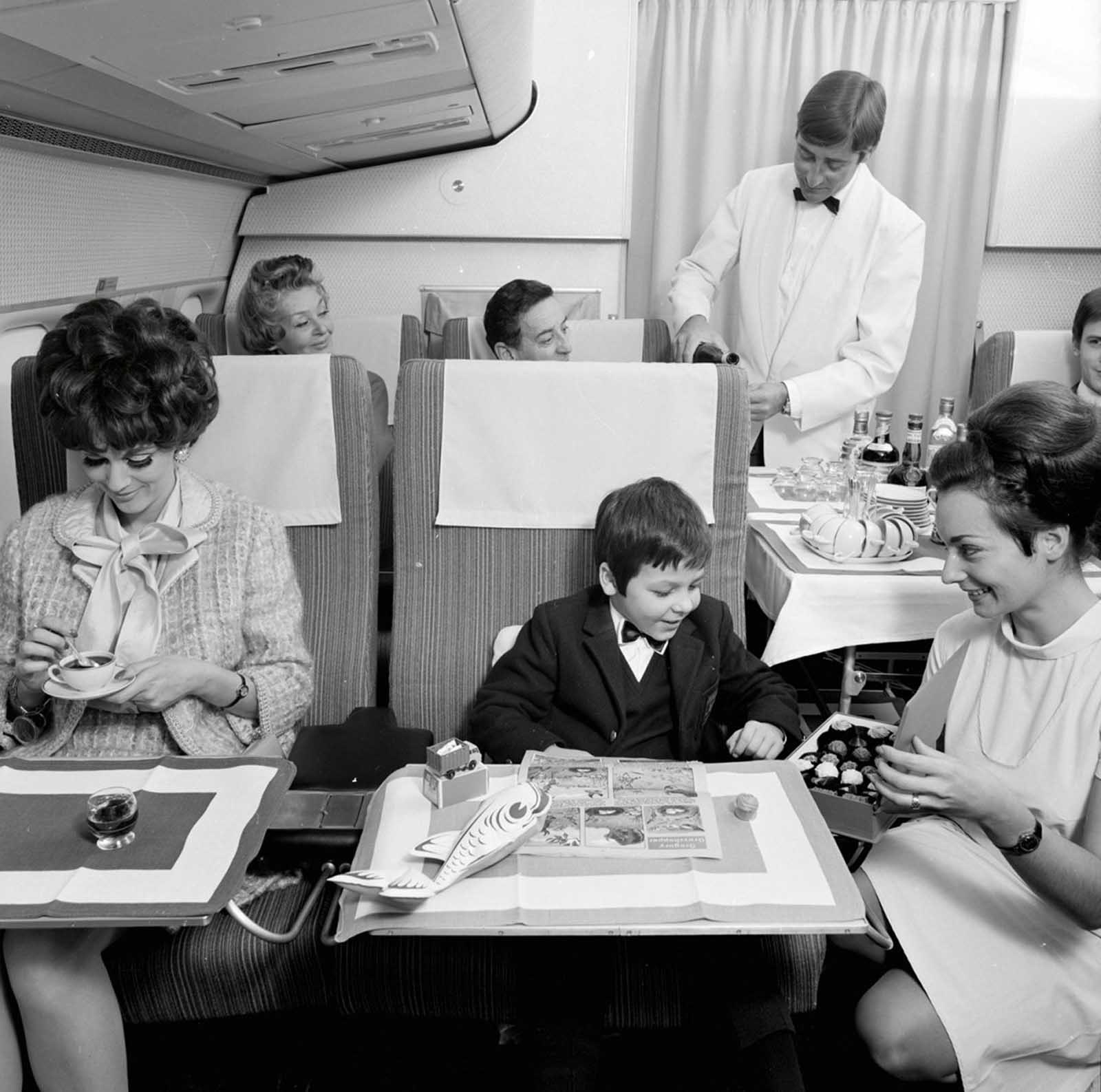
Plenty of room compared with today’s airplanes.
And because the stewardess-to-passenger ratio was so much higher back then than it is today, you could expect one to nearly instantly cater to your every (non-salacious) need.
It should also be mentioned that the Golden Age of Flying was an era of sumptuous design, a time in which the flying experience–from the visual look of the cabin to your stewardess’s uniform, right down to the silverware–was imagined by some of the world’s best designers.

As airplanes evolved the concept of traveling by air became something of potentially broader appeal, and the airlines acted to make air travel more comfortable and more genteel.

The flight attendants had to show a combination of look, social manners and waitresses skills.

A flight attendant with high fashion hairstyle brings the menu.
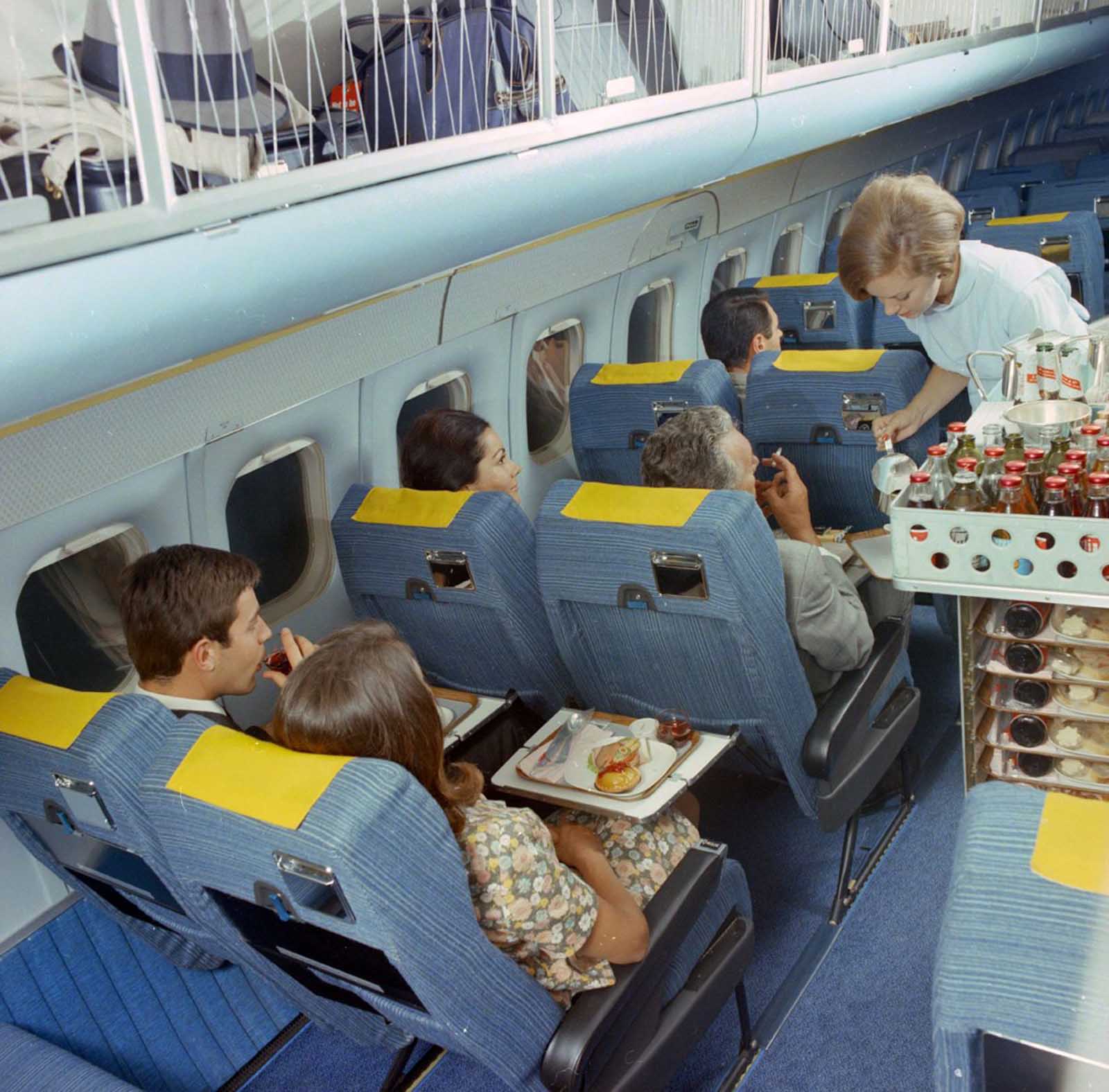
No disposable plates.
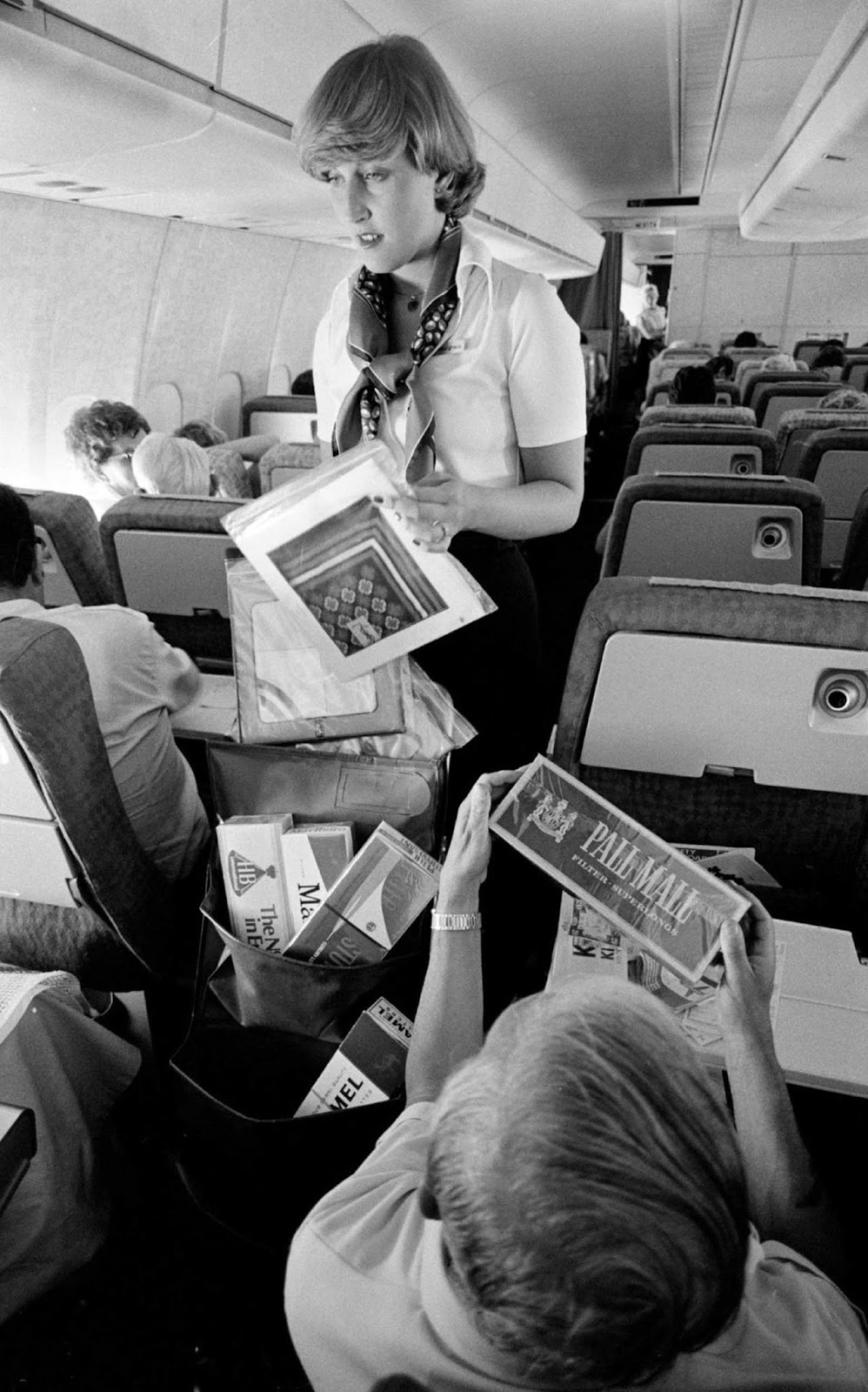
Smoking during the flight was normal.
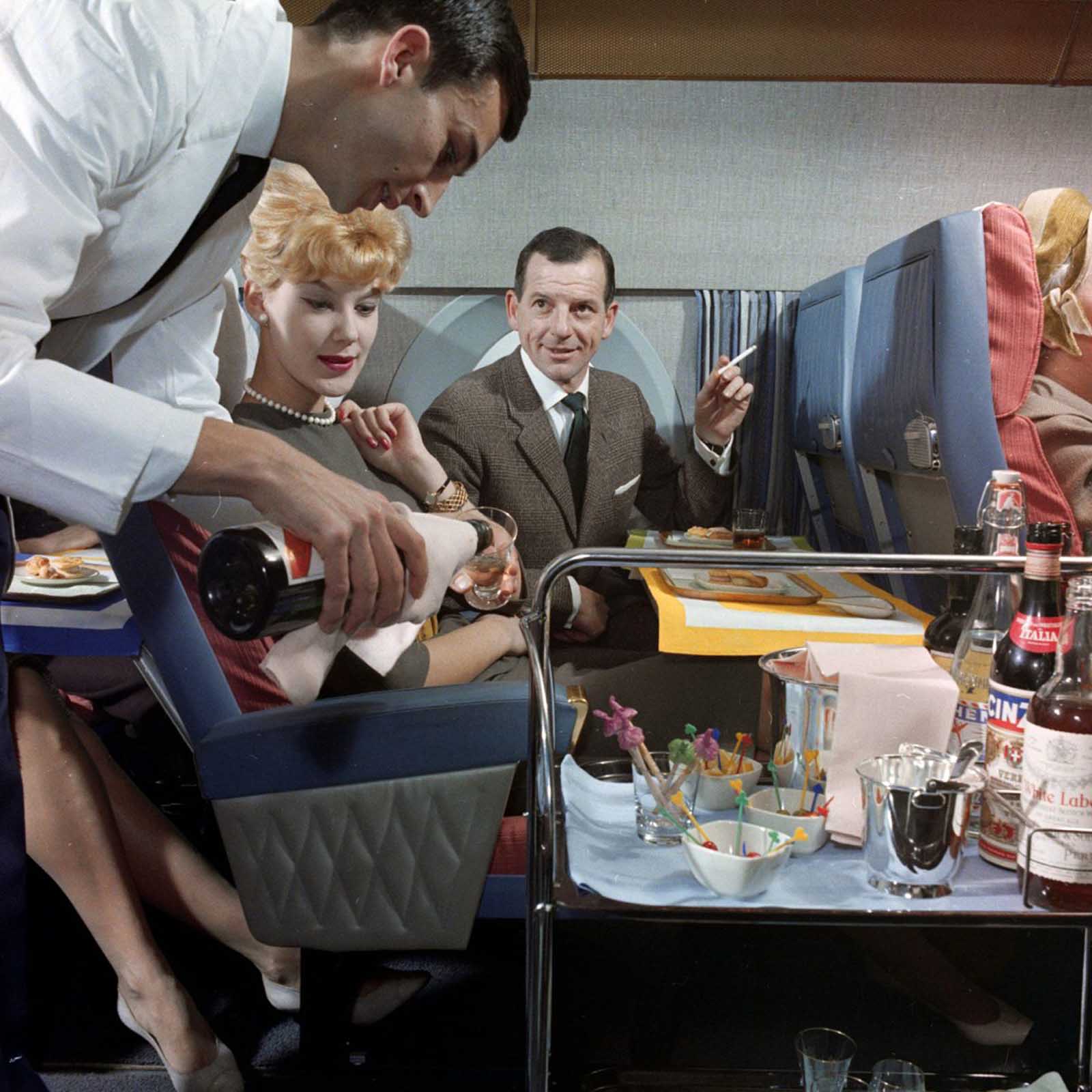
The passengers were offered unlimited alcohol.
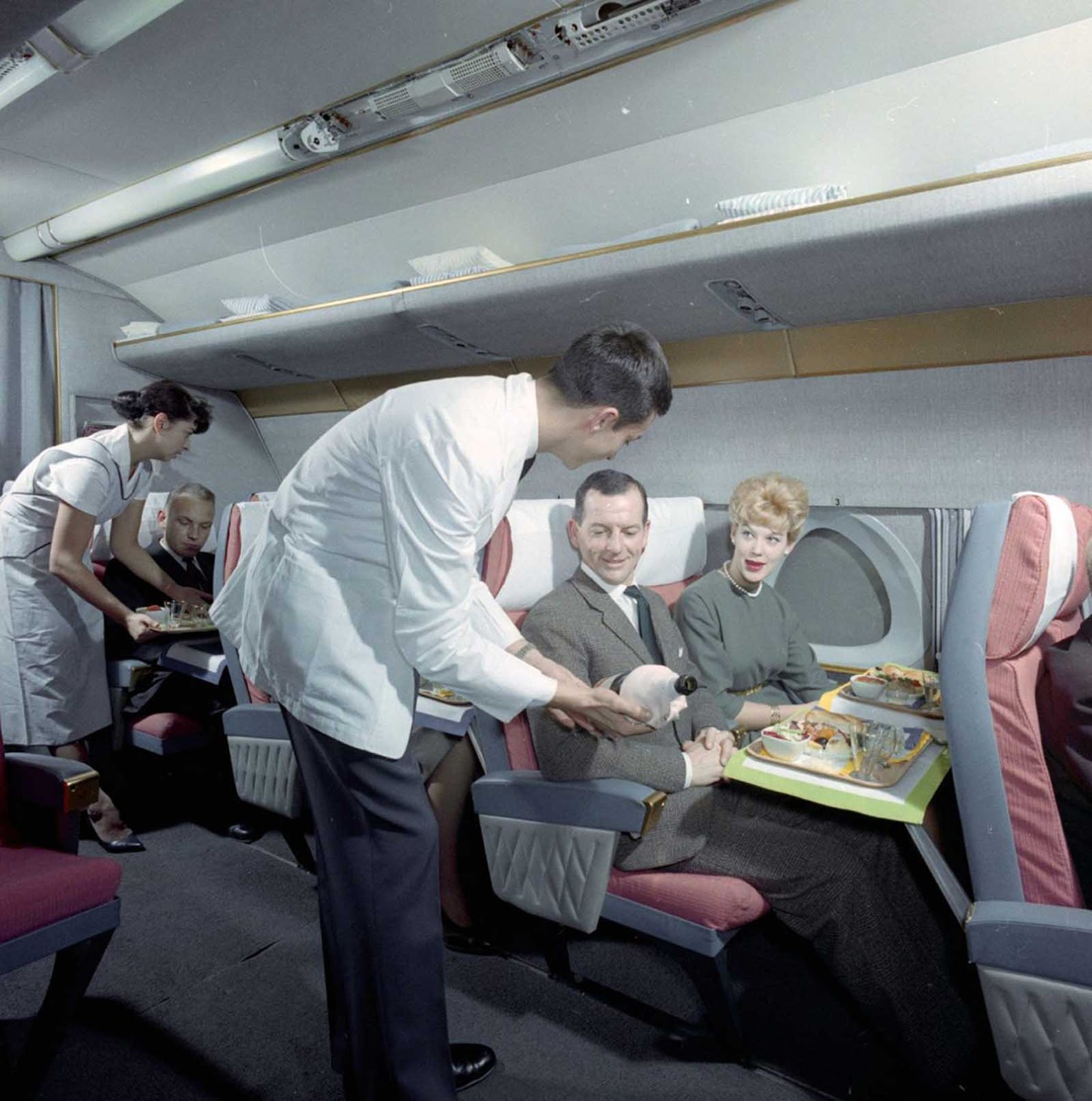
There was a fine selection of wines!
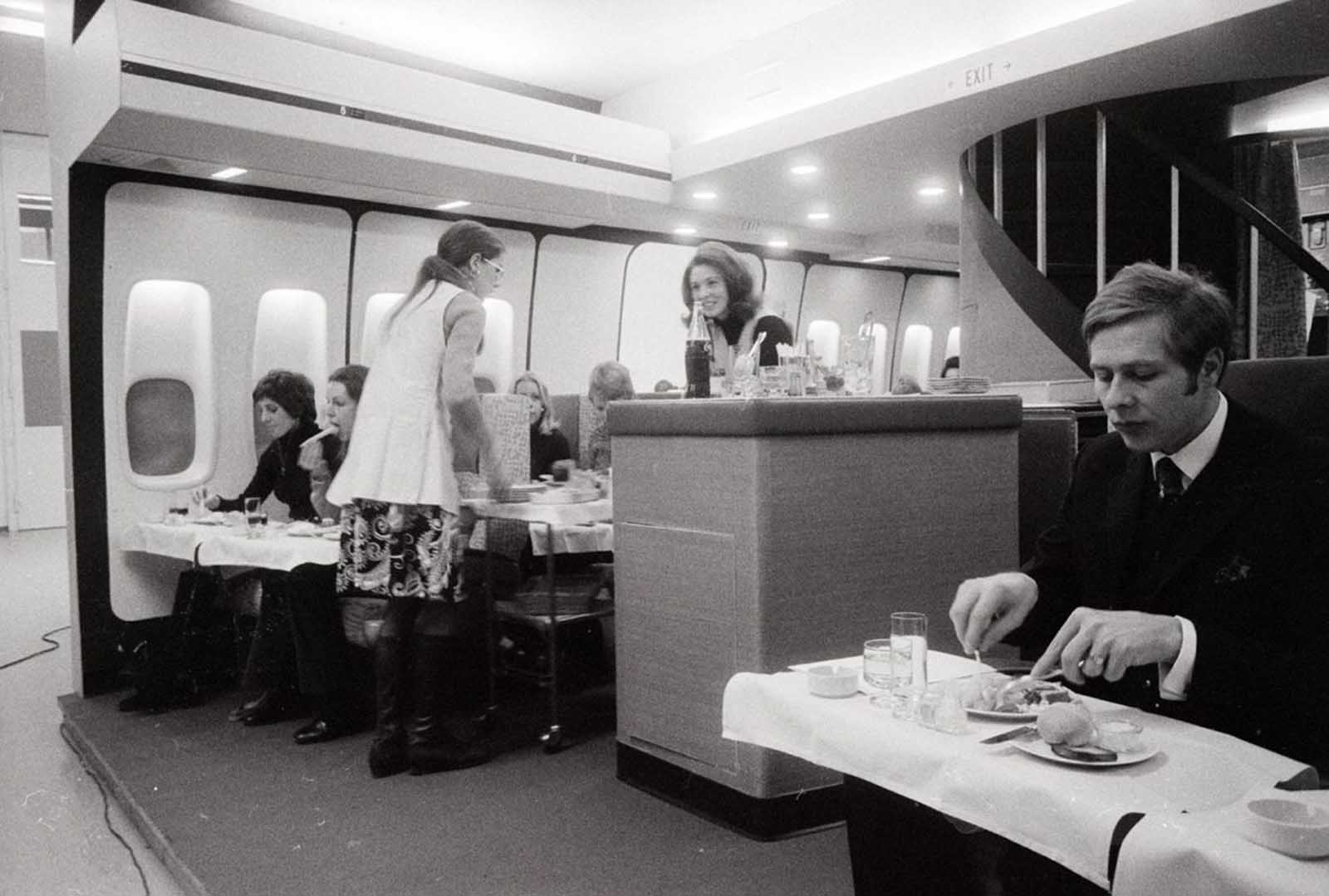
Looks like an ocean liner.

Did anyone get drunk?

A couple flying first class in 1960s.

There was a wide variety of food selections offered by these airliners.
Updated on: July 25, 2024
Any factual error or typo? Let us know.

THE FLASHBAK SHOP
Visit the shop
Living the Dream at 35,000 ft: Flying First Class in the 1960s
It’s a bittersweet experience looking at these pictures of Swissair passengers eating like kings, being waited on hand-and-foot, and enjoying abundant legroom. Sure, a small percentage of passengers today still enjoy the comfort of first class, but it’s nothing like it used to be. Worse still, the economy class seats have become cramped hellholes, making these pictures from the 1960s seem even harder to look at. Still, if you can muster the resolve, it’s an interesting look at the Golden Age of Air Travel.
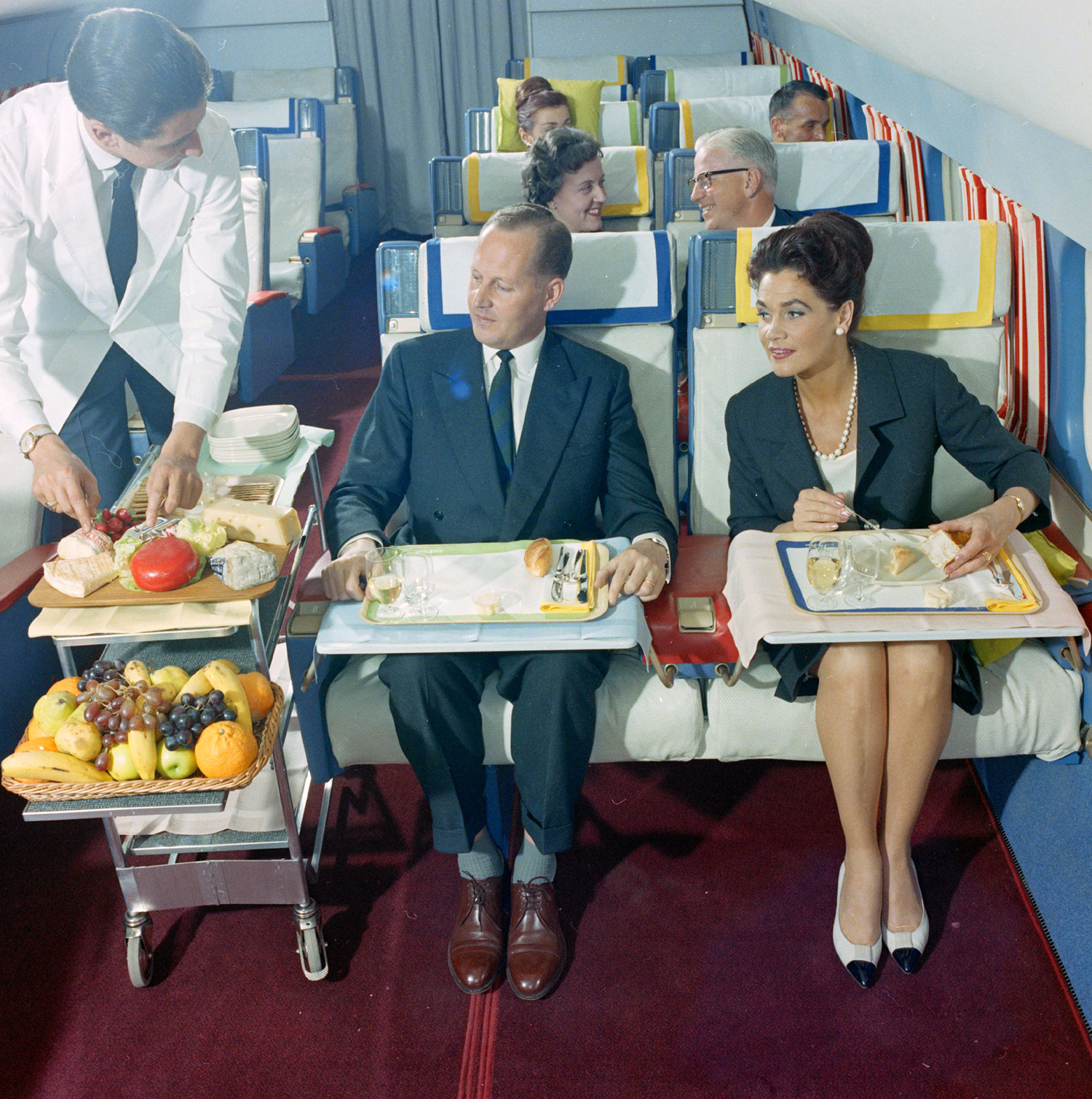
These days, we get tossed a tiny bag of peanuts… and we’re grateful for it. Again, I understand these are photographs of first class service, yet I still am green with envy for the 1960s airline experience.

Note that all these photographs are via the Swissair archives. Were other airlines similarly luxurious? There were certainly degrees of luxury, but overall the answer is an emphatic “yes”. (For more on this, see this post from a few years back: 4 Ways Air Travel Has Become Objectively Terrible .)
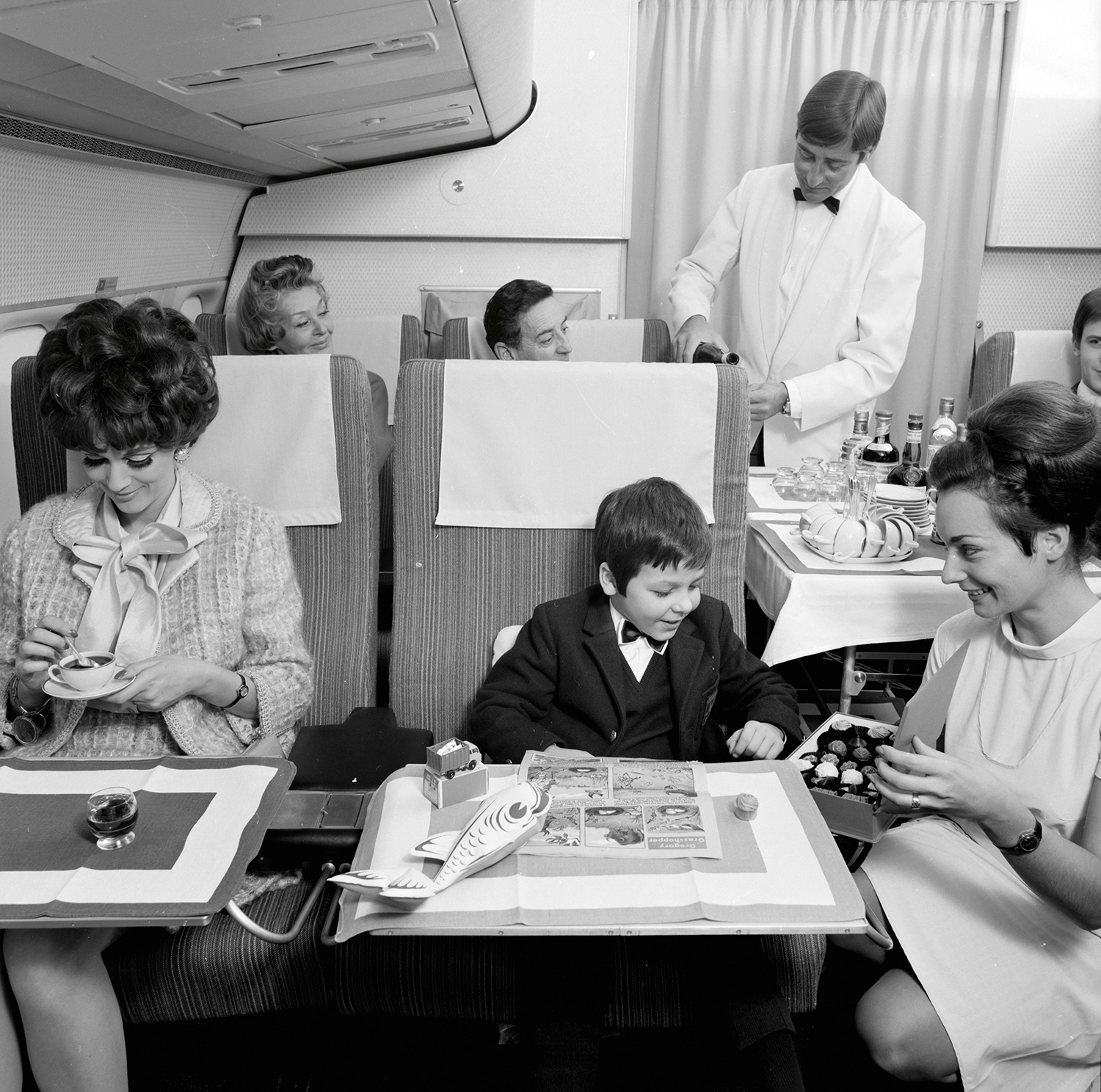
Surely, this is a mock set of the Swissair plane – there’s no way the aisle was actually this wide.
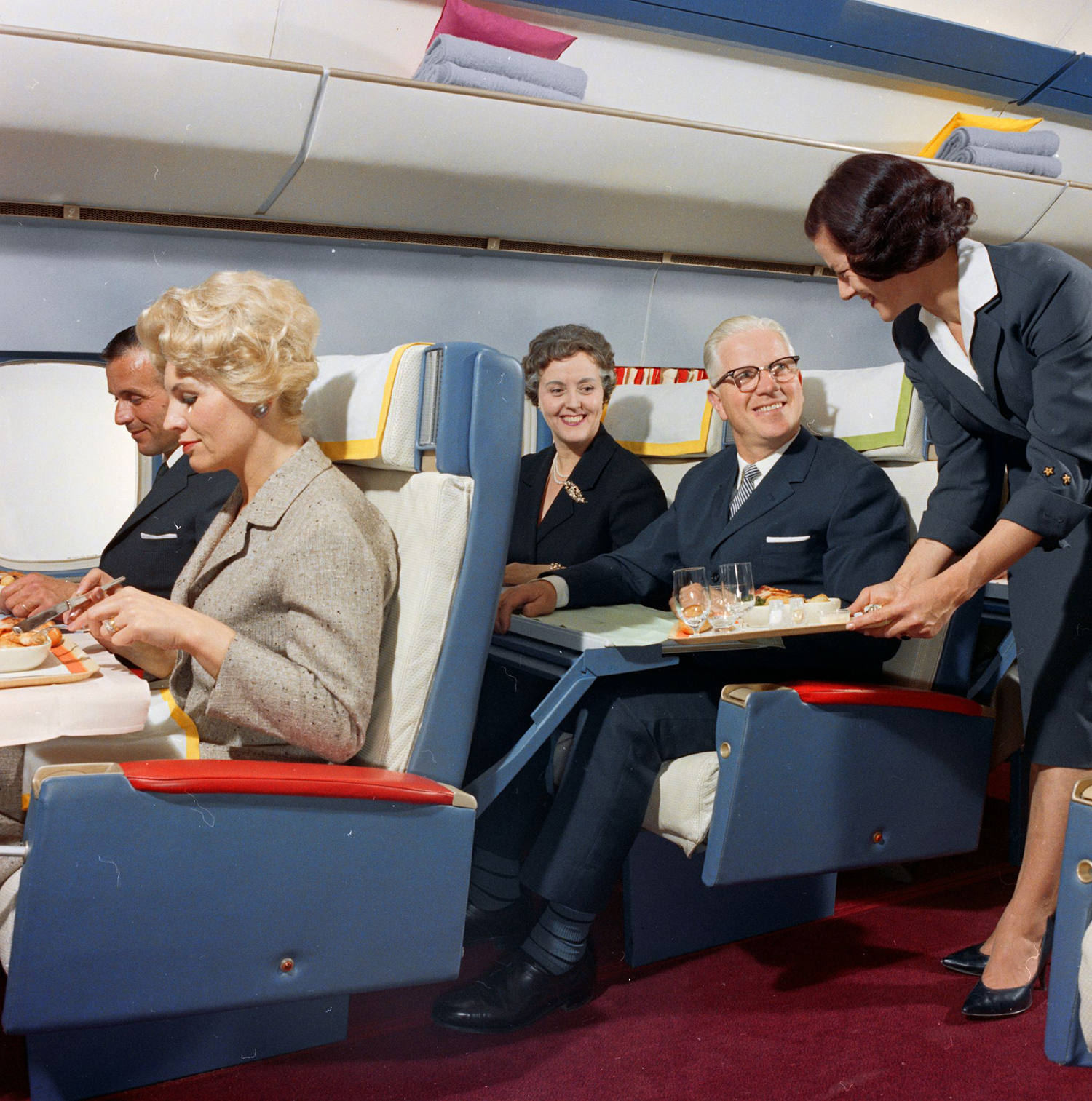
I detect economy seating (yet still, the fabulous food service continues). I also detect ashtrays. Can your mind even comprehend smoking on an airplane these days? Check this next picture out to understand the true extent of smoking at 35,000 feet.
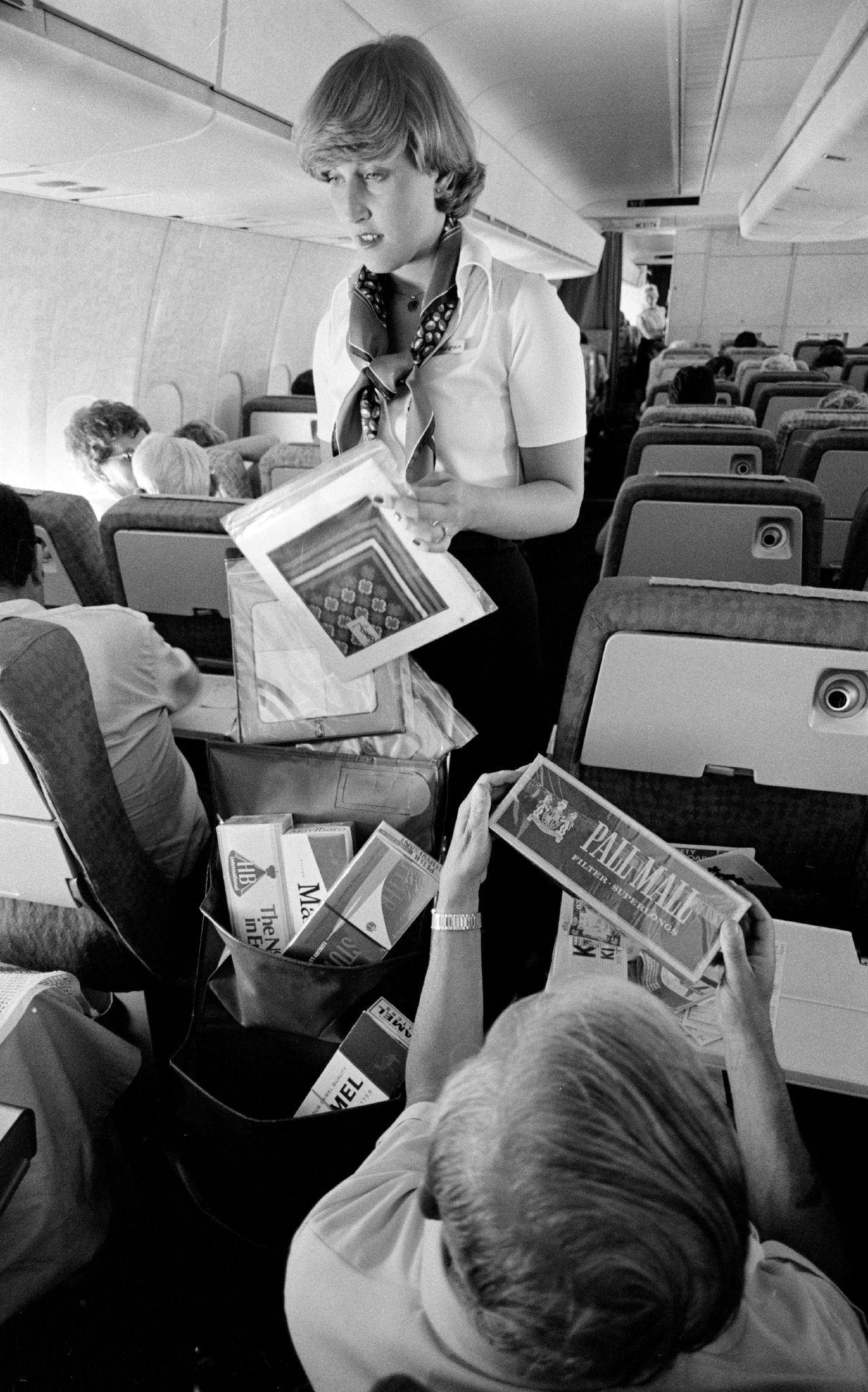
Yeah, that’s right. The air hostess is doling out literal cartons of cigarettes for the passengers to choose from. It was a different world.
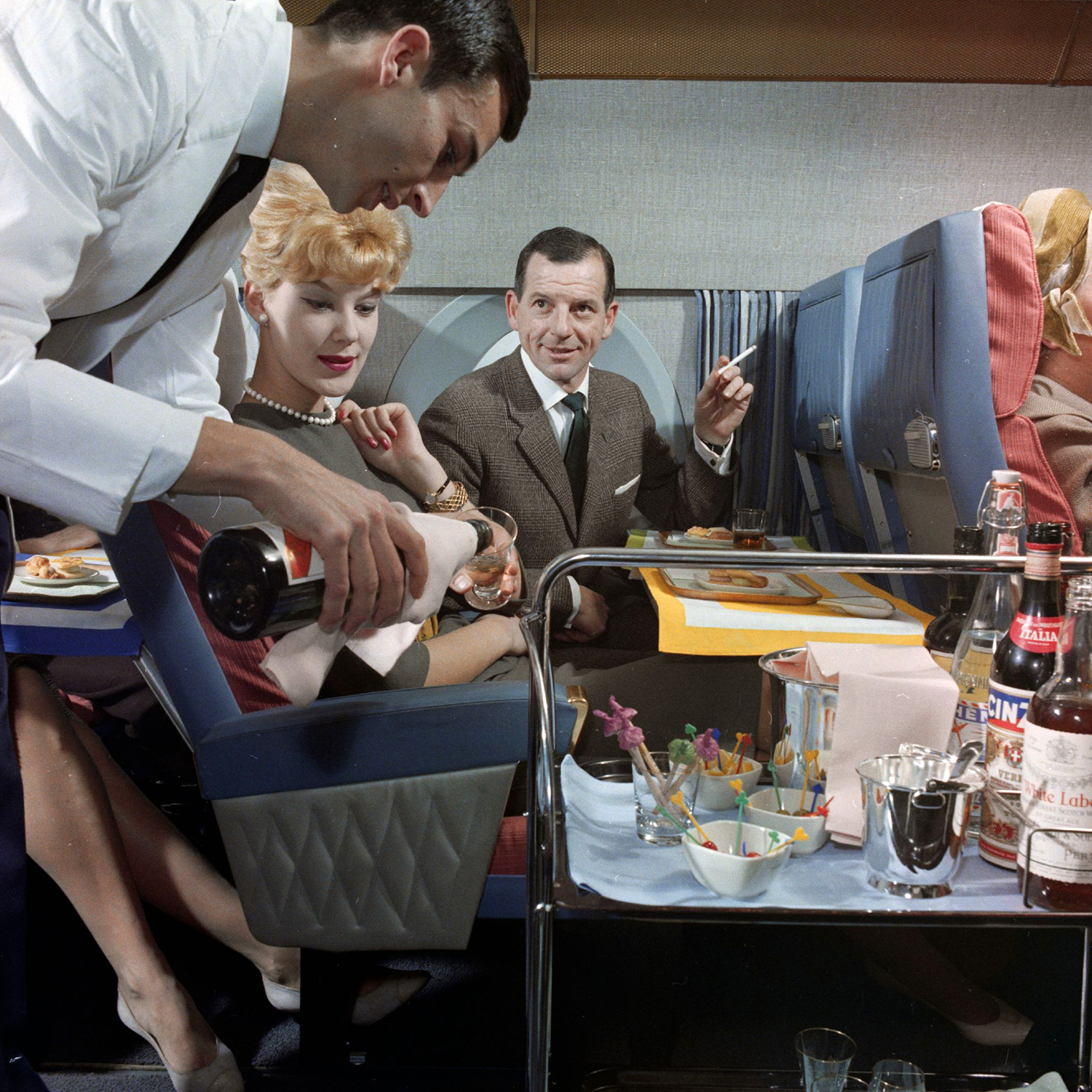
Enjoy cocktails and cigarettes during your trip.
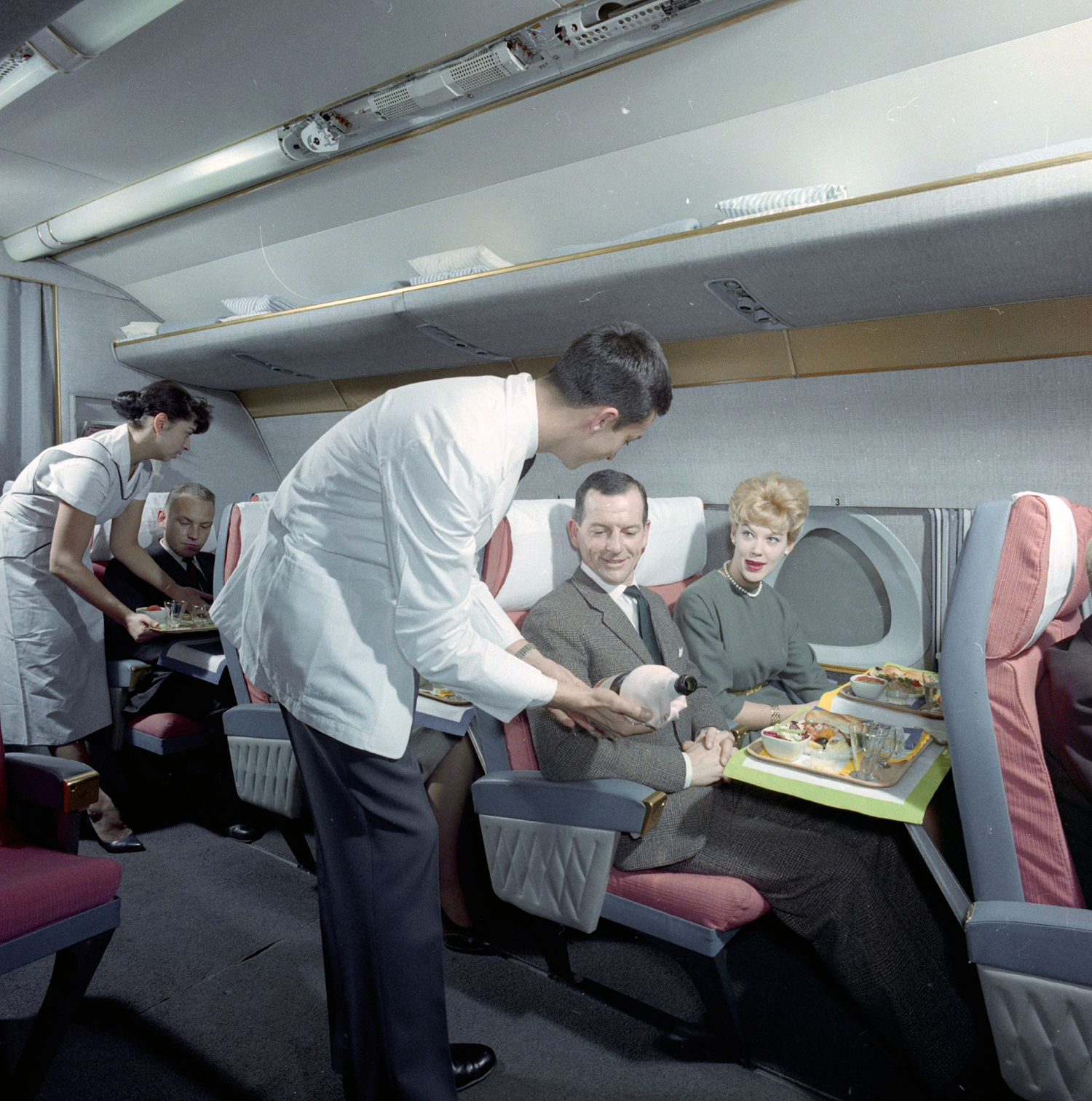
Would you like to support Flashbak?
Please consider making a donation to our site . We don't want to rely on ads to bring you the best of visual culture. You can also support us by signing up to our Mailing List . And you can also follow us on Facebook , Instagram and Twitter . For great art and culture delivered to your door, visit our shop .
15% off 3 or more T-Shirts

Recent Posts
Eating At The Montreal Restaurant ‘Famous for Its Little Pig’ – 1938-1972
The Boston Years: On The Streets 1972-75
Real Family Photos: A Mother Photographs Her Seven Children’s Chaotic Coming Of Age
Windows In Time: The New York City Years, 1975 – 1980
Erté’s Naked Alphabet, 1967
Editor’s picks, collect our postcards.

Free Newsletter
You might also like.

Plan Your Visit
- Customize Your Visit
- Directions & Parking
- Hours & Admission
- Food & Drink
- Museum Store
- Accessibility & Amenities
- Group Visits
- Private Events
- Special Offers
- Visiting From Out Of Town
- Tours & Experiences
- Non-English Speaking Visitors
- Buy Tickets
- Find an Aircraft
- Explore The Museum
- Help Me Explore
- Air & Spacecraft
- Collections & Research
- Museum Galleries
- Step Inside
- Aircraft Restoration
- Chronicles Of The Museum
- Who Are You?
- Explore Programs
- Educator Resources
- Testimonials
- Educational Grant Assistance
- About Education
- Volunteering Opportunities
- Sign Up For A Program
- Project Welcome Home
- Opportunities to Give
- Giving FAQs
- Giving: The Fine Print
- Contact Development
- Join or Renew Membership
- Membership Levels & Benefits
- Corporate Membership
- Membership FAQs
- Member Events
- Discounts & Special Offers
- Partner Museums
- In The Community
- Pathfinder Awards
- Trustees & Leadership
- Aloft Magazine
- Annual Reports
- Privacy & Terms
- Admission Pass Donation Policy
- Sign up for Flight Plans
- Col Anderson Project
- Collections Donation Page
- Frequent Flyer
- Support the AM Flight Breakfast
- Teague Donation Form
- Support Project Welcome Home
- Project Welcome Home Keepsakes
- Project Welcome Home Tribute Wall
Being a Stewardess in the 1960s
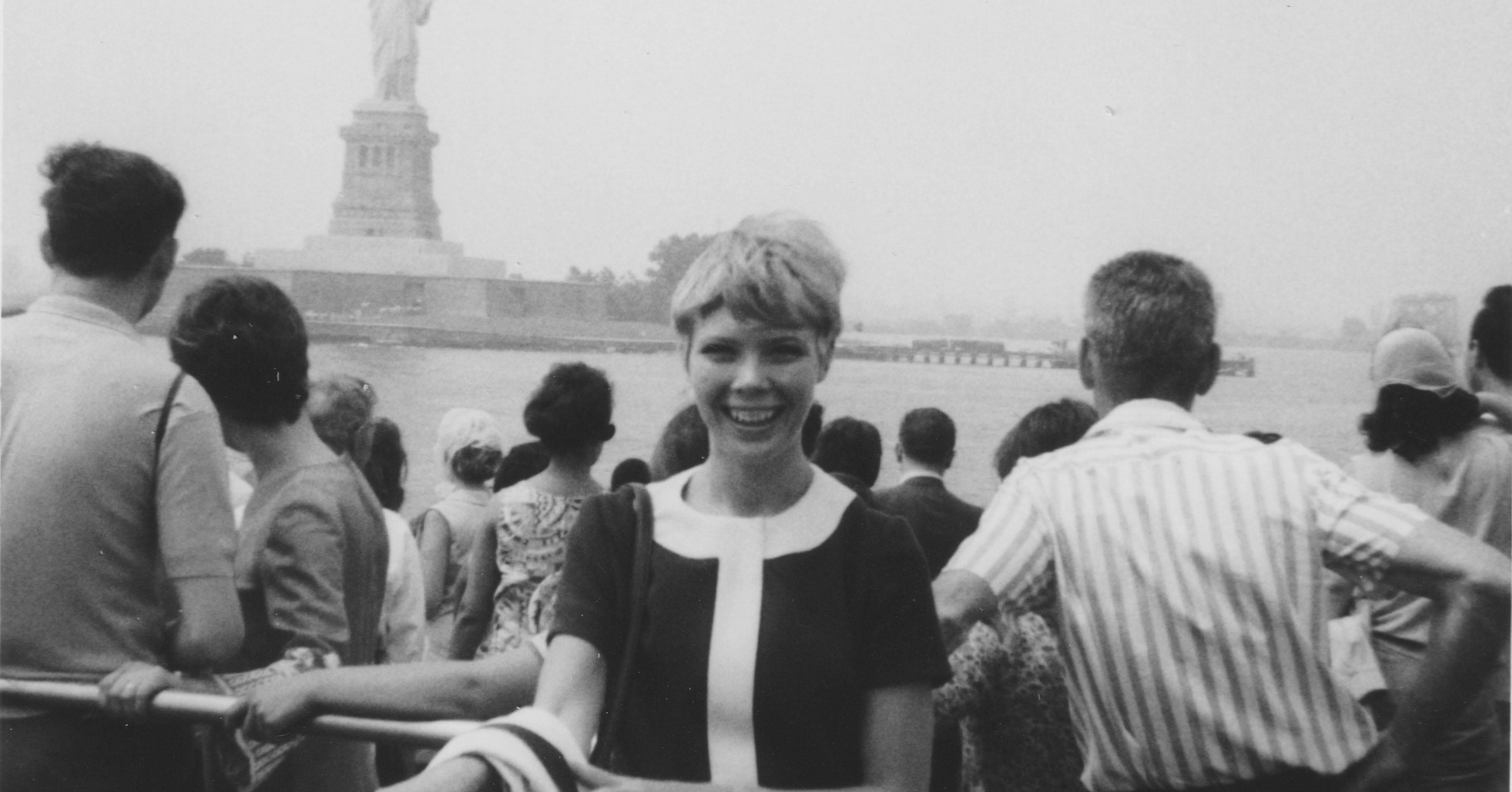
“I just got hired by United Airlines to be a Stewardess.” My cousin proudly told me. Why don’t you apply?” So I did, was accepted, and two months later we boarded an airplane and flew off to Chicago for training. That was in 1968, when flying was a unique experience. The 1950’s and 1960’s were called the Golden Age of Flying, so-called because of the glamorous stewardesses, great meals (sometimes gourmet meals) and lots of legroom. Men wore three-piece suits and ties, ladies wore dresses, high heels and jewelry. A far cry from today’s flights and dress codes.
What did it take to become a Stewardess in 1968? Below is a list of United Airlines required qualifications:
United Airlines Stewardess Qualifications (1968) Females only Age: 21-27 Height: 5’2”- 5’9” Weight: Proportionate to height but no more than 135 lbs. Education: High School graduate Vision: 20/40 or better without glasses Work Experience: 3 years public contact experience Must be unmarried. No children. (Widow or Divorcee will be considered but must not have any children.) Must be attractive, have no blemishes, have a pleasant personality, hair neatly groomed (must be natural, no colored hair) and must be no longer than shoulder length.
Once an application had been accepted, an interview was conducted and you were informed if you were hired or not. (In 1968, only 1 in 30 applicants were hired). That was it!! No second or third interview, not even a resume (what is that?) was needed. The next step was a flight to Chicago for seven weeks of intense safety training on every type of aircraft flown by United, how to serve meals and a beverage service, and of course: grooming; make-up; and if you smoked, the proper way to smoke a cigarette.
Next you were assigned to a base in a certain city. Bases were determined by availability and seniority. Since I was still in flight training my seniority was determined by age; after a base was assigned, seniority was determined by training graduation date. Then finally you were a stewardess! At least until you were 32 years of age, married or pregnant all of which would be cause for termination.
Today’s requirements are a bit more complex. Now aspiring flight attendants are required to not only have the above basic requirements (although many have been changed to reflect today’s standards), but you also have to pass physical requirements, tests and interviews.
Some of the major changes of policy include the ability to be married, have children and the job is open to all who apply regardless of age, sex, race or social preferences. In 1968 only females were accepted. The attitude at the time was summed up by the Daily Press in Newport News, June 23, 1966: “To present a pleasing public image can be achieved only by an attractive girl.” An ad for United in 1967 boasted, “Marriage is fine! But shouldn’t you see the world first?” And Mary Wells, mastermind behind Braniff’s ad campaign, proudly told Business Week in 1967, “When a tired businessman gets on an airplane, we think he ought to be allowed to look at a pretty girl.” Things have certainly changed!!
Flying in the 60s and early 70s was fun. Because the “loads” were light we had time to enjoy our passengers. Many times I would sit down and play cards with a passenger. I remember carrying on a conversation with a very elderly man who told me how as a small child he came “Out West” with his family in a wagon train. Our flight training taught us to treat passengers like they were friends over for a get-together. When we could, we would.
We also had time to play jokes on each other. For example, the Boeing 727 was one of the airplanes that I flew many times. Of course, they were a bit different then as they are now. There were no overhead bins but open overhead racks, which only held coats and hats. One time I was helping train a new stewardess and we (with the help of the pilots) put her in the overhead rack to show her how much weight it could hold (not a usual training exercise). We left her up there for boarding. Being a professional stewardess, she calmly waved and smiled as each passenger came on. We did help her down when there was a break in the boarding process. Laughing, she swore she would get back at us.
Not every flight was enjoyable. I was working in First Class, busy serving drinks and taking meal orders. I approached one seat, took the gentleman’s order and asked his wife what she would like. There was no answer, figuring that she had not heard me I repeated the choices in a slightly louder voice. Again no answer, whereas the husband looked up at me and said,” My wife doesn’t speak to servants”. Thankfully not everyone who flew thought that way.
Flying was an adventure that was constantly changing with new uniforms, new planes and more people flying. In June of 1970, United started to fly the Boeing 747. New planes and routes were usually given to more senior stewardesses. Being a fairly new stewardess I did not have the seniority to fly on one until United acquired the Pacific routes from Pan American Airlines in 1986. As much as I enjoyed traveling within the United States, I now had the seniority to move to the International Base instead of the Domestic base, and with the new Pan Am routes United was not just a domestic airline anymore and my travel options greatly expanded. By now I was a Flight Attendant (the term Stewardess was changed to Flight Attendant at the end of 1970), could be married, have children and not worry about being older than 32. Since I qualified in all three categories it was a good thing that flying had changed since 1968.
During my time at United Airlines, I experienced severe turbulence, a cabin decompression, bomb threats (during the Vietnam War), a thwarted hijacking, and an emergency landing (landed safely). But despite all this, I had the opportunity to explore the world from Hong Kong, Tokyo and London to Mexico City, Guatemala and San Salvador. The places I’ve been to, the experiences I’ve had, and the friendships I’ve made over my 35-year career will be memories never to be replicated. I wouldn’t change a thing. I feel fortunate to have been a stewardess, and a flight attendant.
Lynda Eck – Lynda now is on The Museum of Flight team leading Premium Experiences on the Museum’s 747 and with Customer Service in the Museum Store.
Topics: Air Travel
In-cabin Service with a Smile
Doing our stretches while training in Chicago, 1968
On the Ferry to Liberty Island, 1968
At the airport in my new United uniform, 1968
The New Stewardess and Proud Mom, 1968
Lynda Eyk, a Portrait in Uniform, 1968-69
Recent Posts
Posts by topic.
- History (34)
- Storytelling (11)
- travel (10)
- technology (9)
- Vietnam (7)
- airlines (7)
- astronaut (7)
- Collections (6)
- Engineering (6)
- SpaceTravel (6)
- Seattle (5)
- aviation (5)
- Black History (4)
- Fighter Aces (4)
- Personal Courage (4)
- Behind the Scenes (3)
- Star Wars (3)
- education (3)
- Air Force (2)
- Boeing Academy for STEM Learning (2)
- Early Aviation (2)
- Fighter Pilot (2)
- Insider (2)
- Untold Stories (2)
- Air Travel (1)
- Amelia Earhart (1)
- Astronomy (1)
- Halloween (1)
- Indigenous People (1)
- Jerry Coy (1)
- John F. Kennedy (1)
- Lunar Roving Vehicle (1)
- Moon Landing (1)
- Museum Insider Mondays (1)
- Pacific (1)
- Pete Conrad (1)
- Scale Models (1)
- animals (1)
- community (1)
- mystery (1)
Subscribe for Blog updates
Sign Up for Our Flight Plans Newsletter Subscribe
- Visitor Guidelines
- Community Access
- COVID-19 Disclaimer
The Museum of Flight, 9404 E. Marginal Way South, Seattle, WA 98108-4097
206-764-5700
- Privacy / Terms
©2022 The Museum of Flight - All Rights Reserved.
- Travel & transport
Air travel in the 60s
Glamour, luxury and style?

Flying is not what it used to be. In the 60s it was glamorous and stylish. To fly meant you had arrived, you were part of the jet set. Certainly flying was still for the privileged few, but was it that glamorous?
In the 1969 film, "Billion Dollar Brain", Harry Palmer (Michael Caine) received a telephone call on an old Bakelite black telephone. A talking computer told him to go to West London Air Terminal and pick up a package from a locker. He took a taxi to West London Air Terminal at Cromwell Road, Kensington. In the locker were a thermos flask and an air ticket to Helsinki.
West London Air Terminal, built in 1963, was a modern, efficient looking building. It had a departure lounge and check-in desks, but no aeroplanes ever landed or took off from there. After check-in passengers and their luggage were transported by bus to Heathrow. The terminal was used exclusively by British European Airways (BEA).
Air travel had an image of glamour and excitement in the 60s. Air travel was for the rich and famous. The 1963 film "The VIPs" tells the story of a group of wealthy people stranded at Heathrow by bad weather. As well as Harry Palmer, the most famous 60s spy, James Bond, travelled by plane to Jamaica (in "Dr No") and Miami (in "Goldfinger"). The phrase "Jet Set" conjures up an image of well-healed and sophisticated international travellers. Today air travel seems far from glamorous. Yet even as far back as the 'fifties flying was opening up to ordinary people as well.

The effect of this change was that by the end of the sixties the actual experience of flying was already losing some of its appeal. Subscribers to "Which?" magazine picked up on a few of today's favourite moans: queues, crowding, delays whilst waiting for luggage and damaged luggage. The airlines themselves had been wrestling for years with the problem of transporting increasingly large numbers of people.
In the early 'fifties there was only one class of travel: first or better than first class. Such luxuries as cocktail bars, and even beds had been provided on transatlantic flights. Fares were expensive and passengers were either very wealthy or claiming the trip on expenses. By the end of the fifties, there were four classes of travel, deluxe (better than first), first class, tourist class and economy class.
Deluxe services gave passengers the very best that the airlines could offer. On the new jets, there were no flat beds or separate bars. Passengers, instead, had wide reclining seats and superb gourmet catering. BOAC's Monarch service was flying from London to New York with Boeing 707s in 1960. The advert stressed the Rolls Royce Conway engines that powered the 707, confirming that BOAC was still buying British. The 707s had just replaced Comets on this route. It also suggested that this was the Rolls Royce of air services. BOAC claimed that it was the finest service in the world.
The four class arrangements did not last long. Pan American only offered first and economy on its transatlantic jet service by 707 from 1958. In the sixties economy and tourist were much the same. Most European flights offered passengers a choice of first or economy/tourist. British European Airways offered passengers first and tourist. Tourist class passengers were given a seat with 34" pitch. First class passengers enjoyed 42" pitch and greater seat width, together with better food and drink. In Len Deighton's "The Ipcress File", the Harry Palmer character (he had no name in the book) told readers a free drink and an extra 6" of seat width made first class worth the extra money; if it was on expenses that was!
How much more money was it? A flight from London to Helsinki, a trip also made by Harry Palmer, cost 114 first class return and 80 economy by SAS in 1967 (1277 and 896 adjusting for inflation). If you are wondering, the same trip costs 289 economy and 820 business today. There are two interesting points here. Certainly, the trip cost more in the sixties to travel in economy than it does today to travel business class, but business only offers the same legroom as economy did in the sixties. The other important factor is that the price differential is much greater today. If you were able to afford the sixties' economy fare, you might think it was worth paying about forty percent more for greater comfort and better food and a more enjoyable trip. Nowadays it would be hard to justify paying nearly three times as much for the business class fare.
First class menus from the 60s were fantastic. This is from a Swissair menu, from 1966:
- Hors d'oeuvre
- Imported Malossol Caviar, Melba Toast, Butter
- Slices of Foie Gras de Strasbourg, Pumpernickel, Butter
- Fresh, Cold Lobster Bellevue, Chef's Sauce
- Glaced Asparagus Spears, Air-dried Ham, Sauce Mayonnaise
- Thin Slices of Smoked Salmon, Fluffy Horseradish Sauce
- New Zealand Shrimp Cocktail, Cocktail Sauce
- Real Turtle Soup
- Cold Vichyssoise
- Main Courses
- Prime Filet Mignon with Truffles, Potato Balls, Artichoke Bottoms, Grilled Tomato, Salad
- Veal Steaks, Swiss-Italian Style, with thin Layer of Swiss Cheese, Noodles in Butter, Braised Lettuce with Chipolata, Salad
- Poached Breast of Chicken in Curry, Pilaw Rice, Buttered, early June Peas, Salad
- Chops and Cotelette of Spring Lamb, Miniature Potatoes, Buttered String Beans, Salad
- Roast Pheasant en Cocotte, Sauce Smitane, Mascotte Potatoes, Leaf Spinach, Salad
- Swiss Speciality of Minced Veal with Button Mushrooms in Cream Sauce, Spaetzlis in Butter, Salad
- Saute of Filet of English Sole with Truffles, Diced Artichokes, Olive Potatoes, Salad
Travelling economy in the sixties could vary from airline to airline, just as it does today. In 1965 a journalist writing for 'The Aeroplane' made a round the world trip in economy class. He found that six-abreast seats with 34" pitch did not offer enough comfort to sleep. Some airlines even allowed more than the regulation 34" and some even served champagne to economy passengers. Free food for tourist and economy passengers had become common in the sixties. The seats in BOAC's VC10s had a reputation for being particularly comfortable so much so, that this writer felt that they solved the legroom problem. He also found that economy passengers were often infrequent flyers, and that they did not mix well with more seasoned travellers.
One innovation from the sixties that made flying more bearable in the less comfortable parts of the plane was in-flight movies, or IFE (in-flight entertainment). There had been experimentation with in-flight movies as early as 1925. However, TWA was the first airline to regularly show in-flight movies. Their first offering was 'By Love Possessed', shown in 1961.
Passenger experience of in-flight movies in the 60s was vastly different from today. They were only shown on popular long-haul routes. Not all airlines did them, although there was increasing competitive pressure to do so. There could only be one movie per cabin. It was either a video, or a 16mm cine film. United offered a 16mm colour cine system and the choice of several audio channels as an alternative.
Films shown by airlines were necessarily bland. They had to offend no-one and attempt to entertain as many passengers as possible. By 1966 there were over 200 daily feature length movies being shown by the airline industry. They were usually somewhat behind what was on offer in the cinemas. Nevertheless, passengers showed a distinct liking for them.
At the end of the 60s there were two radical developments that promised to shape the future of air travel: jumbo jets and super sonic travel. Concorde demonstrated supersonic travel in 1969 and the airlines were primed to take up Boeing's new 747 jumbo jet. At the time it seemed that supersonic travel would soon be a part of our lives, but it was the jumbo that really set the pace for the future. The first airline to fly the Boeing 747 was Pan Am. Their first commercial flight was in January 1970.
So was air travel in the 60s more glamorous? If you were flying first class, possibly yes. Paradoxically first class was more affordable in the 60s than today. Against that you had to make do with a mere 42" pitch, bettered in most business class seats on long haul flights today. There were fewer people flying in the 60s, so there was probably a greater chance of being next to an empty seat in economy than today. Some economy seats were better than others and most offered the regulation 34" pitch, putting most of today's carriers to shame. But with limited in-flight entertainment and no free drinks, it was hardly that much better than economy travel today. It was more a question of attitude. Flying itself was exciting. It isn't today.
Your comments
Add comment.
- Terms & conditions
- Privacy policy
Mid Century â Facts & Figures â Collectibles

- Pounds, shillings & pence
- Imperial weights & measures
- Prices & incomes
- Babies' names
- Social history
- Food & drink
- Collectibles
- Vintage technology
- School days from the past
- Shops & shopping
- About Retrowow
â Mid Century â Facts & Figures â Collectibles â
Cruising The Past Cruise News
Five things cameron’s movie titanic got wrong, in 1960 trans-atlantic steamship line services from new york to europe were still going strong with almost daily sailings – starting at $412.50 one-way first class on the queen mary or queen elizabeth..
Posted by: Michael Grace May 21, 2008
New York’s Liner Row – Early 1960s
The following are listings of schedules and minimum fares for Trans-Atlantic steamship service taken from the April 1960 issue of the Official Guide of the Railways and Steam Navigation Lines. Even in April and May 1960 (less than fifty years ago) there was almost daily steamship service from New York to Europe.
Lines still operating included: American Export, Canadian Pacific, Cunard, Donaldson, Europe-Canada, French, Furness-Warren, Greek, Holland-America, Hamburg-Atlantic, Home, Italian, North German Lloyd, Norwegian America, Polish Ocean, Swedish America, United States Lines, Zim Lines and many more.
In the next decade, with the introduction of the 747, these liner services will have vanished with limited summer crossings from New York to Europe.
Trans-Atlantic Passenger Sailings (Eastbound) April-May 1960.
Trans-Atlantic Passenger Sailings (Westbound) June-July 1960.
Joint listing of First, Cabin and Tourist Class Fares – 1960.
Popular Articles

August 27, 2024

Santa Fe’s San Francisco Chief Pullman Streamliner
August 19, 2024

FEC ruled 2007 Blogs are media – Rep. Mary Bono, Michael L Grace & The Daily Kos
July 27, 2024

S.S. LA MARSEILLAISE “Orient & Indo China” route… from Saigon to the depths of Grenada…
July 21, 2024

Sail Around The World First Class for $855.00!
June 18, 2024

Colin Farrell aborad the SS United States
June 4, 2024

First Gay Cruise 1987 Sailing From New Orleans SS Bermuda Star
May 21, 2024

RMS Titanic – Photos Talen Onboard On The Last Voyage
May 1, 2024
© 2024-2025 Cruise The Past All Rights Reserved.
Any copying or reproduction of images or media herein is strictly prohibited.
- CONTACT MICHAEL GRACE
- Refine your search results by reviewing SEARCH TIPS
- Site tech support provided by Ted Angel

- Visit Our Blog about Russia to know more about Russian sights, history
- Check out our Russian cities and regions guides
- Follow us on Twitter and Facebook to better understand Russia
- Info about getting Russian visa , the main airports , how to rent an apartment
- Our Expert answers your questions about Russia, some tips about sending flowers

Russian regions
- Amur oblast
- Buryat republic
- Chukotka okrug
- Jewish autonomous oblast
- Kamchatka krai
- Khabarovsk krai
- Magadan oblast
- Primorye krai
- Sakha republic
- Sakhalin oblast
- Zabaikalsky krai
- Map of Russia
- All cities and regions
- Blog about Russia
- News from Russia
- How to get a visa
- Flights to Russia
- Russian hotels
- Renting apartments
- Russian currency
- FIFA World Cup 2018
- Submit an article
- Flowers to Russia
- Ask our Expert
Anadyr city, Russia
The capital city of Chukotka okrug .
Anadyr - Overview
Anadyr is a port city in the extreme north-east of Russia, an administrative center of Chukotka autonomous okrug. The city is located in the permafrost zone, on the shore of Anadyr Bay in the Bering Sea.
The population of Anadyr is about 15,000 (2022), the area - 20 sq. km.
The phone code - +7 42722, the postal code - 689000.
Anadyr city flag
Anadyr city coat of arms.
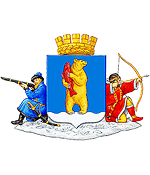
Anadyr city map, Russia
Anadyr city latest news and posts from our blog:.
23 September, 2021 / Uelen - the easternmost settlement of Russia and Eurasia .
3 November, 2020 / Cape Dezhnev - the only place in Russia with the US in sight .
29 September, 2019 / Anadyr - the Easternmost City of Russia .
18 September, 2016 / Anadyr - the view from above .
History of Anadyr
On August 3, 1889, in compliance with the Decree of the Government of the Russian Empire on the formation of the Anadyr okrug in the most northeastern territory of the country, the Russian military doctor and polar explorer Lev Frantsevich Grinevetsky founded the post of Novo-Mariinsk at the mouth of the Kazachka River. This was the beginning of Anadyr.
The construction of the settlement was slow, mainly only state and private trading depots were expanded. By 1914, a long-wave radio station was built here - one of the most powerful in Russia at that time.
Soviet power in Novo-Mariinsk was finally established only by 1924. At the same time, by the decision of the Kamchatka Provincial Committee, the present name of the settlement, Anadyr, was approved. The word “Anadyr” is mentioned in chronicles in different variations: “Onandyr” - a river in Chukotka, “Anadyrsk” - a stockaded town of the mid 17th century (the times of Semyon Dezhnev and Kurbat Ivanov).
In 1927, Anadyr, with a population of only about 200 people, became the administrative center of the Anadyr district, three years later - the center of the newly created Chukotka National District. In 1931, a fishing plant was opened. Near it, the first in Chukotka power station was built. In 1933, the population of Anadyr was already 1,176 people.
More historical facts…
On January 1, 1941, about 3,100 people lived in Anadyr. During the Second World War, Anadyr played a crucial role, first of all, in the implementation of the decision on the construction of the Alaska-Siberia air-route for the transfer of aircraft to the Eastern front. The “Special Air Line”, along which the Red Army received more than 7,000 aircraft under Lend-Lease, began operating on October 7, 1942.
Residents of Anadyr were directly involved in the construction of one of the reserve military airfields. Anadyr permafrost experts made an invaluable contribution to the construction of these military airfields.
A major impetus to the development of the village was the construction of a seaport on the shore of the bay in the late 1950s. In 1963, a dam was built on the Kazachka River, which made it possible to carry out water supply to Anadyr. January 12, 1965, the village of Anadyr received the status of a town. About 5,000 people lived there.
By 1975, the population of Anadyr reached 10,300 people. The average age of the locals was a little over 25 years old. In 1980, Anadyr became the administrative center of the Chukotka Autonomous Okrug. In 1984, the first non-stop regular flight of the Il-62 aircraft was performed along the route Moscow - Anadyr. In 1989, Anadyr celebrated its 100th anniversary.
In 2001, a period of intensive renewal and development began in Anadyr. This was due to the election of Roman Abramovich for the post of Governor of the Chukotka Autonomous Region. In a short time, the capital of Chukotka was renovated and partially rebuilt.
Anadyr views
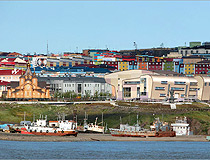
General view of the center of Anadyr
Author: Lystseva Marina
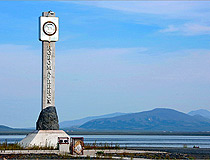
Stele on the shore in Anadyr
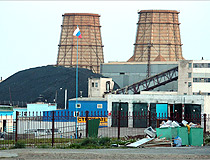
Anadyr Thermal Power Plant

Anadyr - Features
Located in the border zone, Anadyr is the easternmost city of Russia. The distance from Anadyr to Moscow, if you fly by plane, is about 6,400 km.
There is a fish processing plant in the city. Near Anadyr, at Cape Observation, one of the largest wind farms in Russia is located - the Anadyr Wind Power Plant. In the vicinity of the city, gold and coal are being mined. Reindeer husbandry, fishing, and hunting are also developed.
The seaport of Anadyr is the largest in the region and connects the city with Petropavlovsk-Kamchatsky, Vladivostok, Magadan, and other ports. Its facilities allow processing up to one million tons of various cargoes. The navigation period lasts four months (from July 1 to November 1).
The airport of Anadyr is located on the other side of the estuary in the village of Ugolnye Kopi. To connect the city with the airport, helicopter flights are carried out year-round. In winter, there is an ice crossing; in summer, there are also boats and small boats cruising. The airport has an international status, regular flights are carried out to Moscow and Khabarovsk, as well as to a number of settlements of Chukotka.
In 2012, construction began on the Kolyma federal highway (P-504), which will provide Anadyr with year-round transport links with the road network of the Russian Far East.
A lot of residential houses in Anadyr are painted in bright colors, and the facades are decorated with images of various animals, fish, tambourines, and shamans. This is done to revitalize the gray landscape of the tundra.
The brown bear on the emblem of Anadyr symbolizes the power of Russia, as well as the rich nature of Chukotka. The fish in the paws of the bear shows that Anadyr is a fishing center.
Holy Trinity Cathedral, located in the center of Anadyr, is the world’s largest wooden Orthodox church built on permafrost (Lenina Street, 21). The church seats about 1,000 people. Next to the church, you can see the largest monument of St. Nicholas the Wonderworker in the world - the height with the pedestal is more than 10 meters.
Anadyr is the sister city of Bethel located in western Alaska (the United States).
Climate of Anadyr
The climate of Anadyr is subarctic, marine, harsh. The average temperature in January is minus 22 degrees Celsius; in July, it is very different from year to year, but on average it is about plus 11 degrees Celsius. The warm period is very short.
Due to its proximity to the sea, winter in Anadyr is warmer and summer is cooler than in the continental parts of Chukotka. Winter is harsh, but softened by the sea, therefore milder than in Siberia at these latitudes. Fogs are frequent in summer. The water surface temperature in the summer months is around plus 10 degrees Celsius.
The absolute minimum temperature was minus 47 degrees Celsius, the absolute maximum - plus 31 degrees Celsius.
Bright colors of the streets in Anadyr
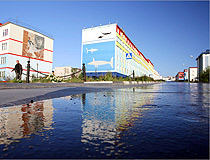
Summer in Anadyr
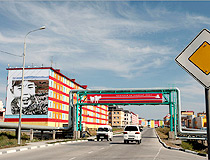
Colors of Anadyr
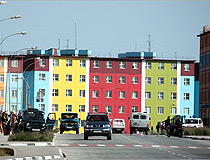
Colorful building in Anadyr
Anadyr Travel Tips
You can reach Anadyr from Moscow by air. Flights take off from Vnukovo Airport several times a week. The flight takes about 8 hours. If it is stormy weather in Anadyr, you may be stuck at the airport for a while.
Also, don’t forget that it is a border zone. Border guards check documents on board. Therefore it is necessary to reserve a hotel in advance and be ready to explain the objective of your trip and the place of stay. Usually special travel agencies organizing the trip deal with all these documents.
Today, Anadyr is a quite modern city adjusted to living. The buildings painted in pink, yellow and blue impress very much especially against the gray background of Chukotka tundra. There are some quite modern hotels too.
Different tourist trips are available, therefore there is always a chance to explore the Chukotka tundra. We also recommend you to visit Chukotka Museum of Local Lore (Rultytegina Street, 5). Opening hours: 10:00-19:00 (11:00-16:00 on Saturday and Sunday).
Anadyr is not like the rest of Chukotka. The city has several hotels, a lot of restaurants and cafes, a movie theater (Otke Street, 15), an indoor ice rink (Chukotskaya Street, 6). There are ATMs and you can pay with cards in most stores. Anadyr has the widest in Chukotka assortment of souvenirs and the fastest Internet. Bike rental is available.
If you are planning to explore Chukotka, then the best time to travel is early spring or the first months of autumn (in summer, roads are often impassable, in winter, it is too cold).
Anadyr city of Russia photos
Pictures of anadyr.
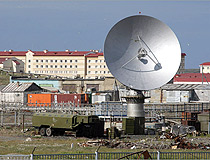
Anadyr scenery
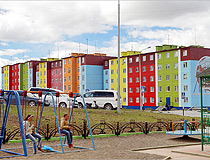
Bright colors of Anadyr buildings
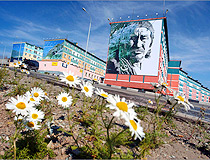
Apartment buildings in Anadyr
Anadyr places
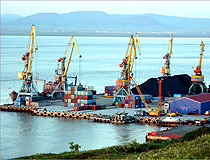
In the seaport of Anadyr
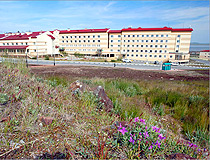
Hospital in Anadyr
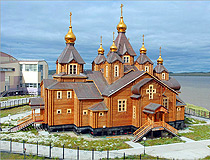
Holy Trinity Cathedral in Anadyr
The questions of our visitors
The comments of our visitors.
- Currently 3.10/5
Rating: 3.1 /5 (221 votes cast)
- EUR (€)
- GBP (£)
- Contact us

- Currency :
- US Dollar Euro Pound Sterling Russian Ruble Australian Dollar Canadian Dollar Swiss Franc Danish Krone Japanese Yen Norwegian Krone Swedish Krona
- Toll Free 0800 011 2023
- US and Canada United Kingdom Australia Brazil Netherlands Russia Sweden
- Tours by Region Moscow Saint Petersburg Golden Ring Lake Baikal Murmansk Siberia & Far East Sochi & Southern Russia Amsterdam Berlin Copenhagen Gdansk Georgia Helsinki Kaliningrad Kamchatka Karelia Kazan Klaipeda Nizhny Novgorod Northern Europe Oslo Perm Riga Ryazan Stockholm Tallinn Ulan-Ude Veliky Novgorod Vilnius Vladivostok Volgograd Yakutia Yekaterinburg
- Why Choose our Day Tours
- One Day Tours Two Days Tours Three Day Tours
- About Russian tours Private vs Group Tours
- Tours by Region Moscow & St.Peterburg Moscow Saint Petersburg Golden Ring Lake Baikal Trans-Siberian Siberia & Far East Altai Kaliningrad Kamchatka Karelia Kazan Perm Veliky Novgorod Yakutia Yekaterinburg
- Tour Types Small Group Tours Private Tour Theme Tour
- Moscow events St. Petersburg events Events archive
- Events by type Ballet Opera Concert Show All types
- Top theaters Bolshoi theatre - Historic Stage Bolshoi theatre - Small Stage Mariinsky Theater Mariinsky Theatre - Mariinsky II Mikhailovsky Theater
- Direction Moscow - St.Petersburg St. Petersburg - Moscow
- Ships MS Rostropovich MS Volga Dream MS Anton Chekhov MS General Lavrinenkov MS Georgy Chicherin MS Ivan Bunin MS Konstantin Fedin MS Konstantin Korotkov MS Kronshtadt MS Maxim Gorky MS Nikolay Chernyshevsky MS Nizhny Novgorod MS Rachmaninoff MS River Victoria MS Scenic Tsar MS Tikhy Don (MS Alexander Borodin) MS Vasiliy Kandinsky MS Zosima Shashkov Mustai Karim
- Russian Visa Invitation
- Moscow The Kremlin Red Square Golden Ring Tverskaya Street Grand Kremlin Palace (The Kremlin) Christ the Savior Novodevichiy Convent Moscow Subway The Bolshoi Theater Armoury Chamber (The Kremlin) St. Basil's Cathedral The Pushkin Museum of Fine Arts Yury Gagarin Cosmonauts training center
- Saint Petersburg Hermitage Museum Peterhof Catherine's Palace (Tsarskoe Selo) Pavlovsk St. Isaac Cathedral Peter and Paul Fortress Nevsky Prospect Yusupov Palace Savior on Blood Amber room Bronze Horseman (Senate square) Hermitage Theatre Kazansky Cathedral Kronstadt Palace Square Spit of the Vasilievsky Island
- 1/7th of the World Volga River Siberia Baikal Kazan Sochi Smolensk Nizhny Novgorod Kaliningrad Ulyanovsk Verkhoturova Island
- uVisitRussia Why travel with UVisitRussia Customers' Testimonials Contact details Cancellations & Changes
- Russian Travel News
- Russian travel advice Advices while packing Advices while travelling
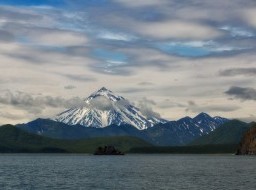
- Shore excursions
- The Best of Two Capitals Private
- The Best of Two Capitals Small Group
- The Best of Two Capitals Gold
- Russia's Ancient Kingdoms
- Cradle of Russia
- Explore Moscow
- Explore St. Petersburg
- Read Customer Testimonials
- Advantages of Traveling with Us
US office 3422 Old Capitol Trail Suite 1252 , Wilmington DE, 19808 USA. US toll-free: 1-888-845-8877 Russian office Ligovsky pr. 57, Office 19, 191040, St. Petersburg, Russia
tel: +7-812-309-5339
© 2001 – 2024 by Northern Crown, Ltd. uVisitRussia and uVisitRussia.com are registered trademarks . Terms & Conditions Privacy Policy
Sign in with your social account

Sign in to our website using your Facebook or Google+ account.
Why Do You Need Our Travel Expert
Contact our experts, and they will help you to plan your best trip to Russia, with attention to every detail!
Our Experts have been in the travel industry for many years, guarantee to offer first class customer service, excellent value for money and unbiased advice. They are standing by to find and build your dream holiday to one of the world's most fascinating destinations - Russia. Your personal Travel Expert will guide you through each stage of the travel process, from choosing a program that fits you best to support during your trip.
Just tell us your e-mail, and we'll take care of everything!
Ask a Travel Expert
Leave your phone number.
Your tour request has been received. Thank you ! We have sent you the confirmation message to [email]
Please make sure that you receive this message (sometimes e-mail messages may go to the spam/junk mail). If you did not get this message, it means you will not get message with the tours' selection as well. If you use a Yahoo!, Gmail, AOL or Hotmail, we recommend to add [email protected] to your address book.
We recommend to leave your phone number. If we will not heard back that you received the e-mail with the tours' selection, we will contact you by phone. And you will not miss the best tour for you.
Thank you ! Your request for Travel Expert assistance has been sent. We will e-mail you within 1 hour.
Sorry, some changes needed
There was a problem with your request.
- Bahasa Indonesia
- Slovenščina
- Science & Tech
- Russian Kitchen
10 places in Chukotka that are worth seeing at least once in your lifetime (PHOTOS)
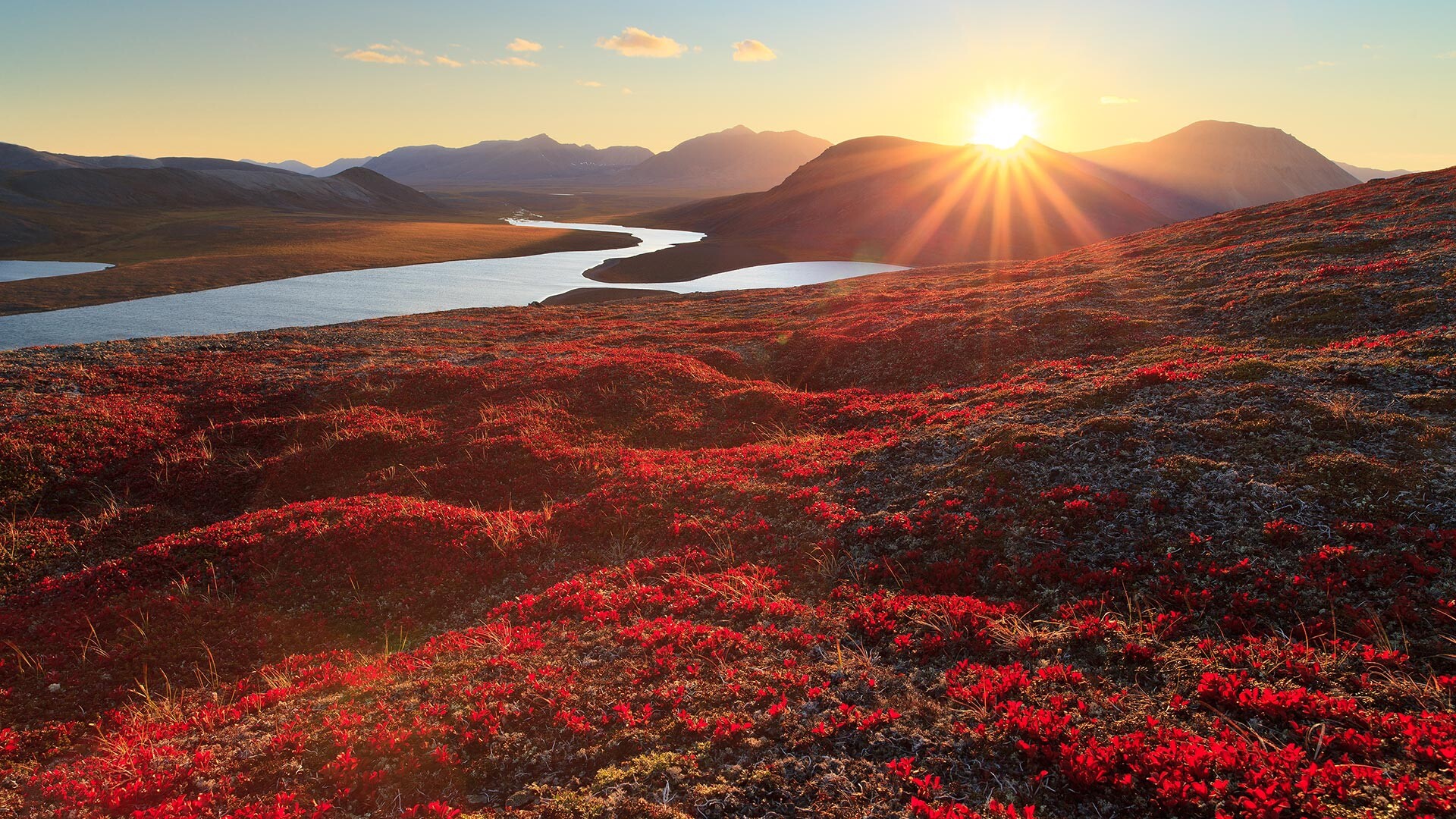
Chukotka is a place where anyone can become a pioneer. This most remote region of the Russian East has boundless tundra, hills that are covered by snow year-round, hot springs and sea animals.
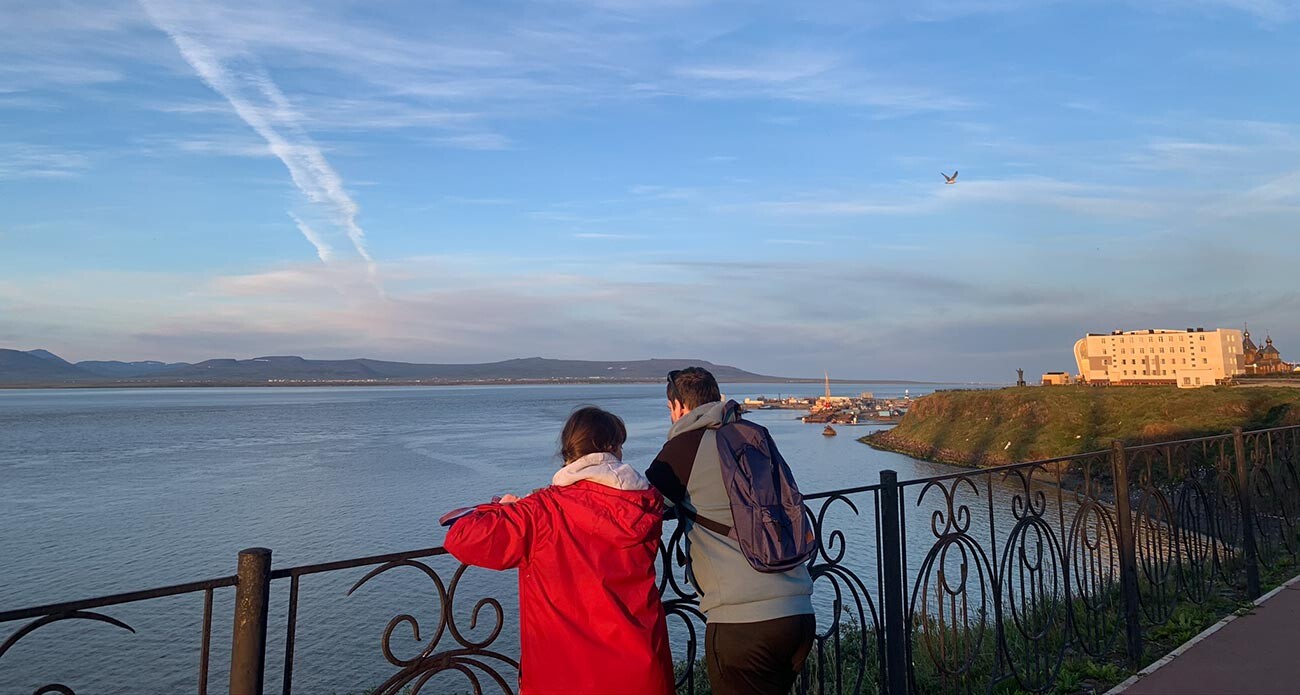
Waiting for a sunset.
Almost all trips through this region begin in Anadyr, the administrative center of Chukotka Autonomous Area. This is a small town (with a population of just 15,000); yet, it seems, Anadyr is the most colorful town in Russia.
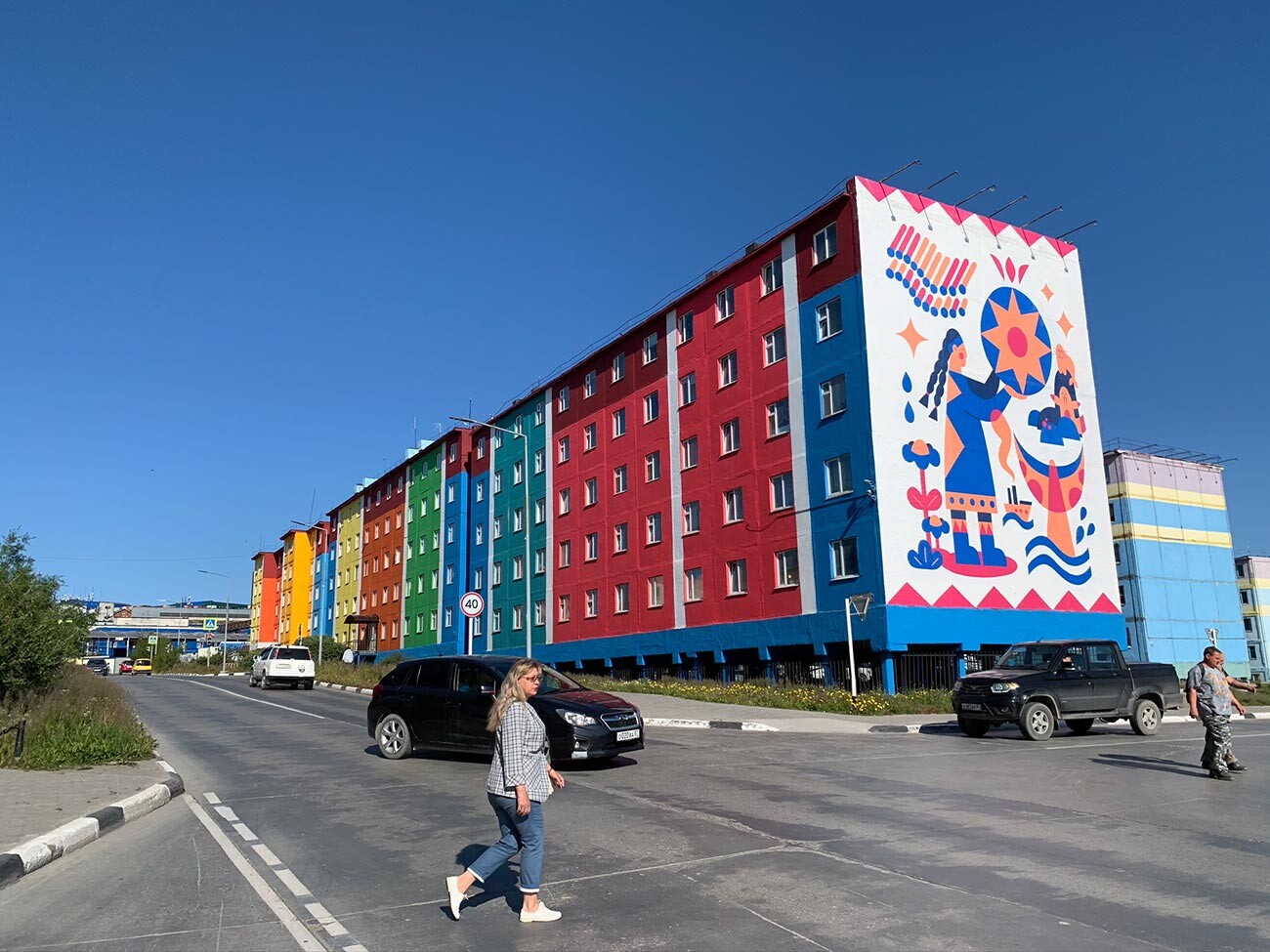
Colorful buildings.
Chukotka’s weather is harsh: it’s often cloudy, its winds are strong and piercing, the summer is short and cold and there’s almost no vegetation.

Anadyr from above.
To boost people’s mood at least somehow, all houses in the local settlements are painted in different colors; in Anadyr, one can also admire beautiful arctic murals (giant graffiti with a specific northern theme): a polar bear sleeping on the moon, a winking deer and abstract art with walruses.
2. Anadyrsky Liman
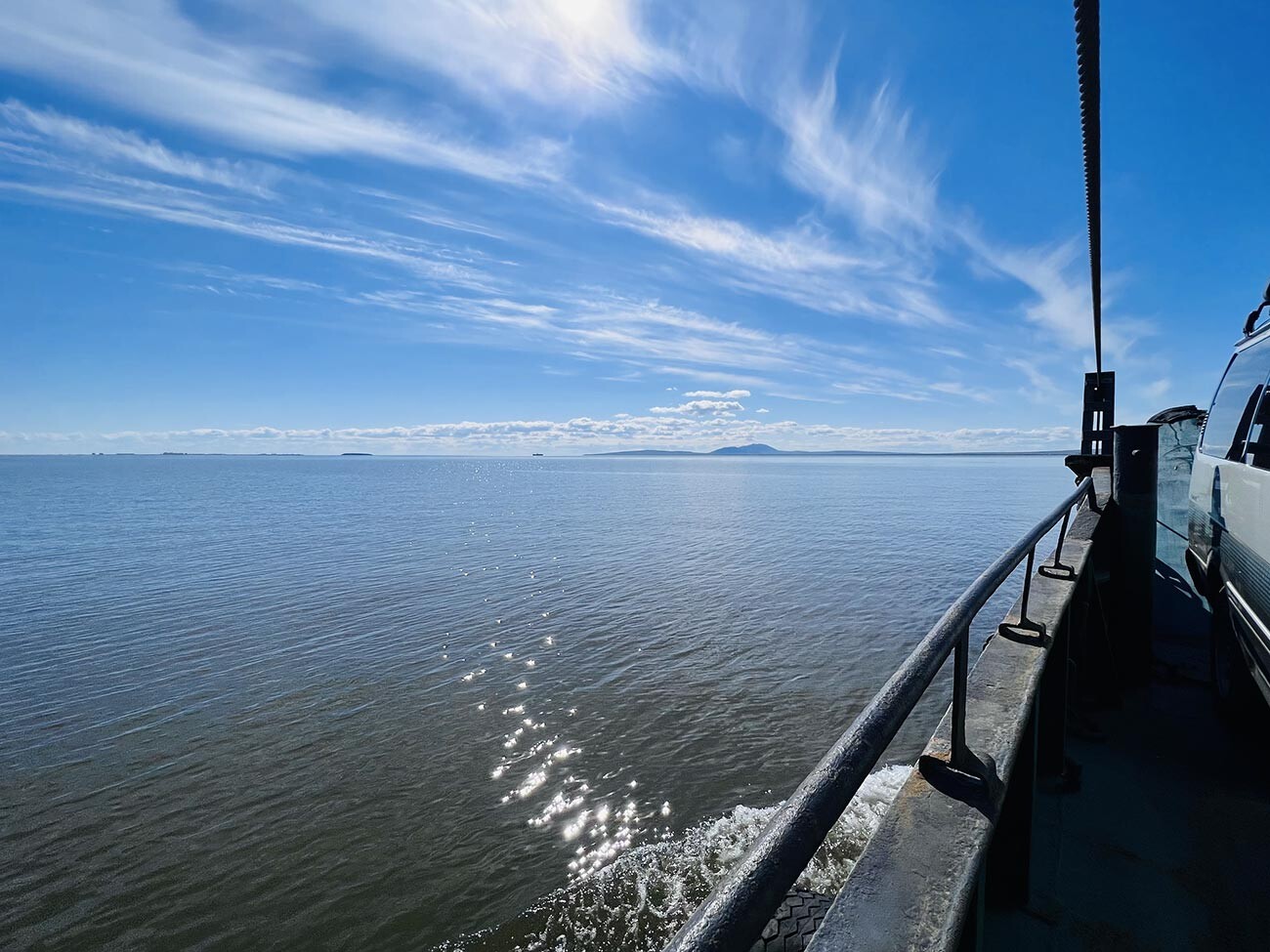
The town of Anadyr lies on an estuary bearing the same name – the gulf of the Bering Sea. This is an incredible place! A huge number of seals and beluga whales (white Arctic toothed whales) live in the estuary and gladly pose for tourists passing by.
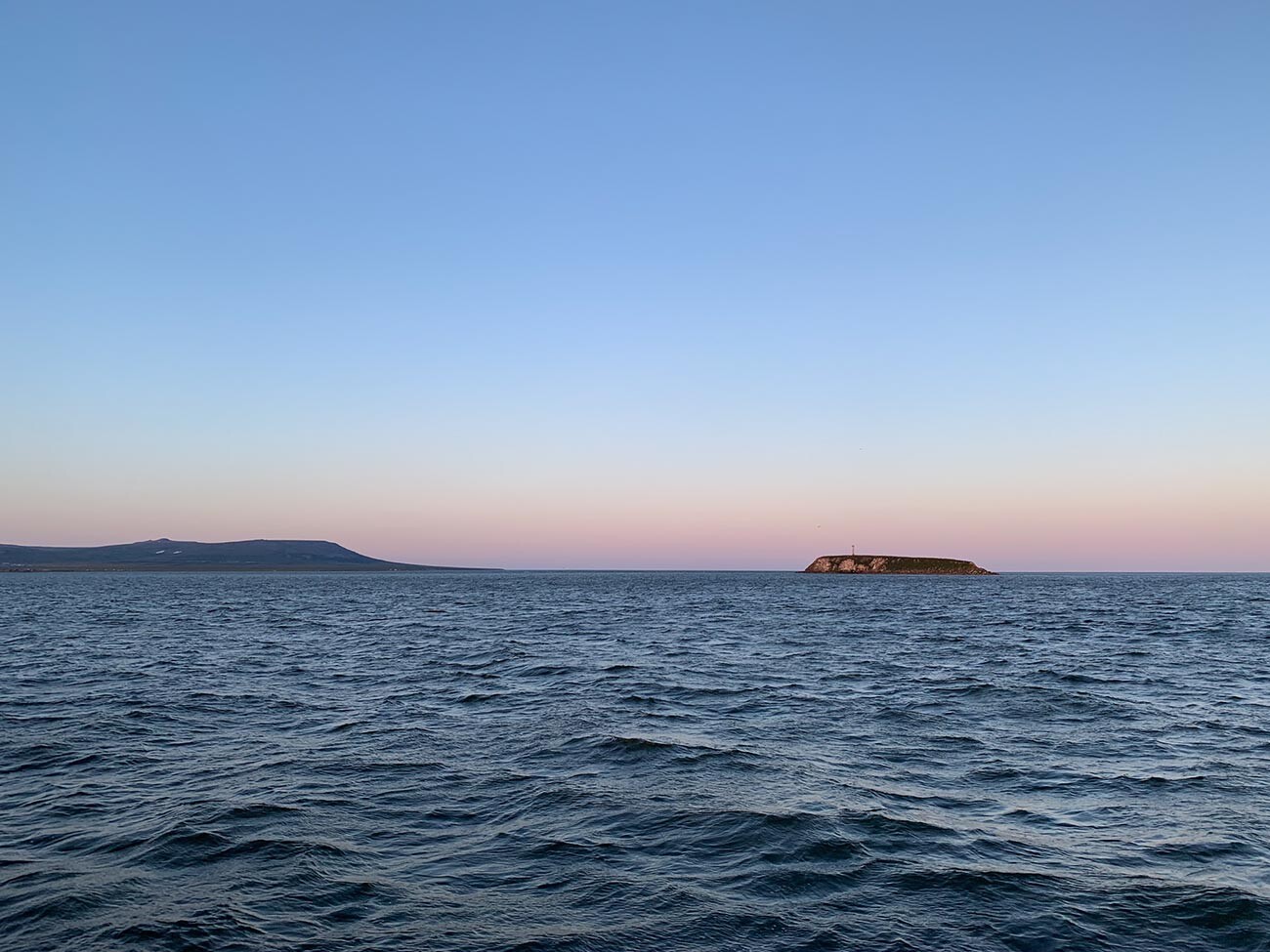
Evening Liman.
There’s no reason to fear them – they’re harmless and just as curious!
3. Beringia National Park
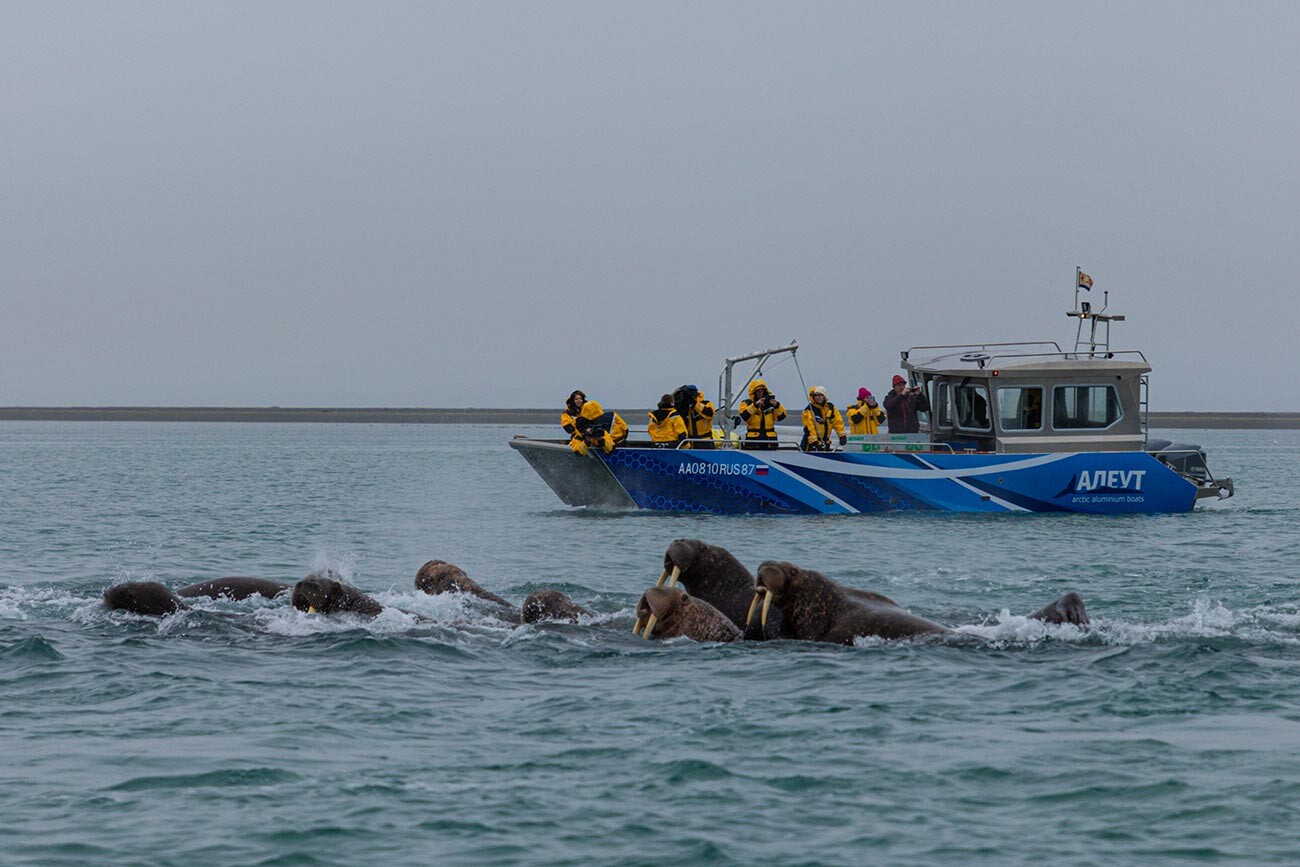
Have you ever heard walruses chuffing?
The sound of walruses chuffing can only be heard in the sea. There are truly amazing places in Beringia National Park, which also includes the coast and the islands of the Bering Sea. One of the parts of the park is the favorite gathering spot for walruses – with their large tusks and booming voices. Another part of the park is a hotspot for playful orcas, showing their tails to human travelers. Yet another part features seals and whales.
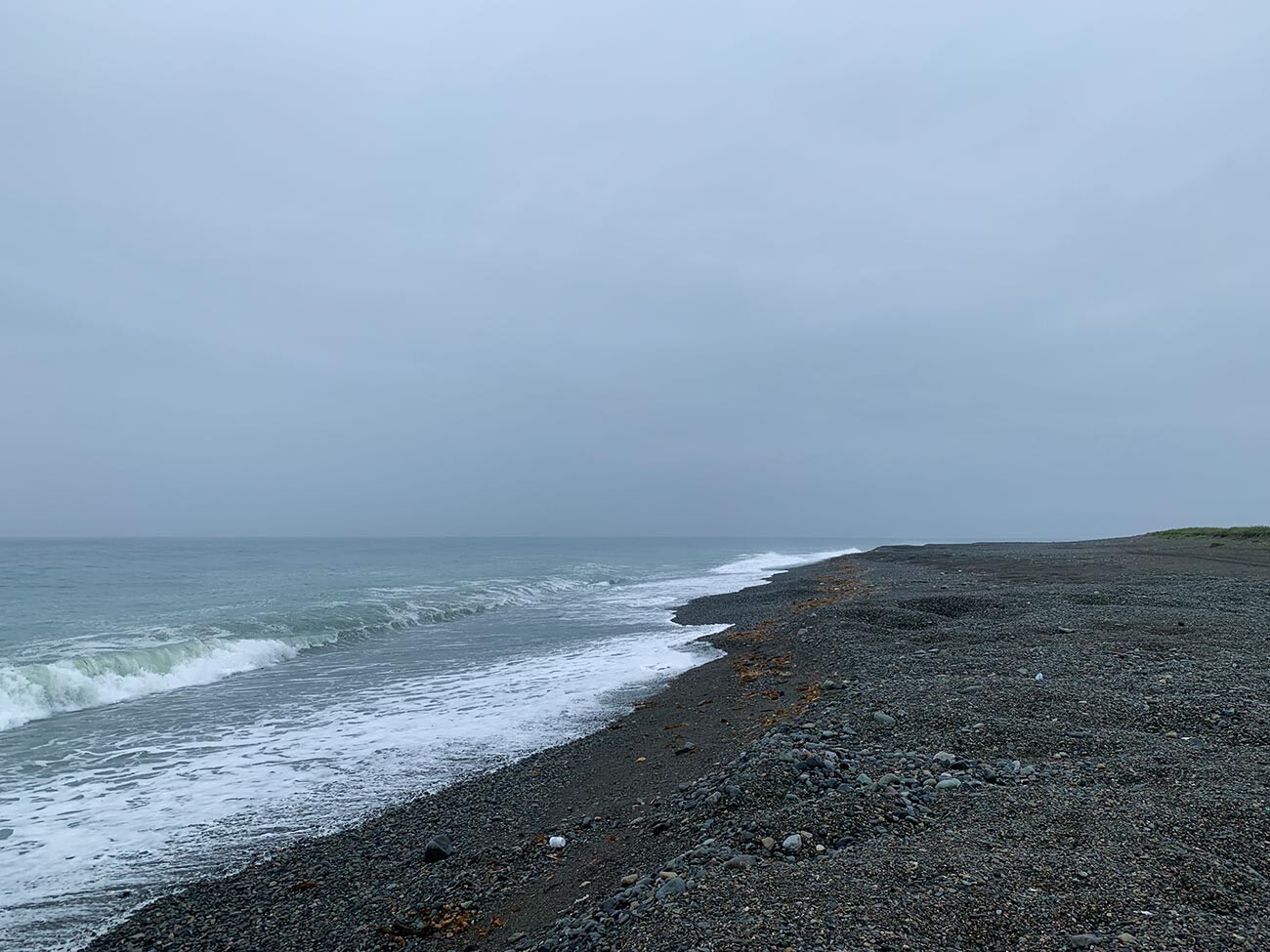
At the Meechkyn spit.
The Bering Sea also has one of the longest spits in the world – called Meechkyn – which is 60 kilometers long. The sand here is like that of the warm seas, claims Alexander Endaltsev, a sea tour guide. “This is the only place between Anadyr and Egvekinot where you can enter the bay and hide from the wind.”
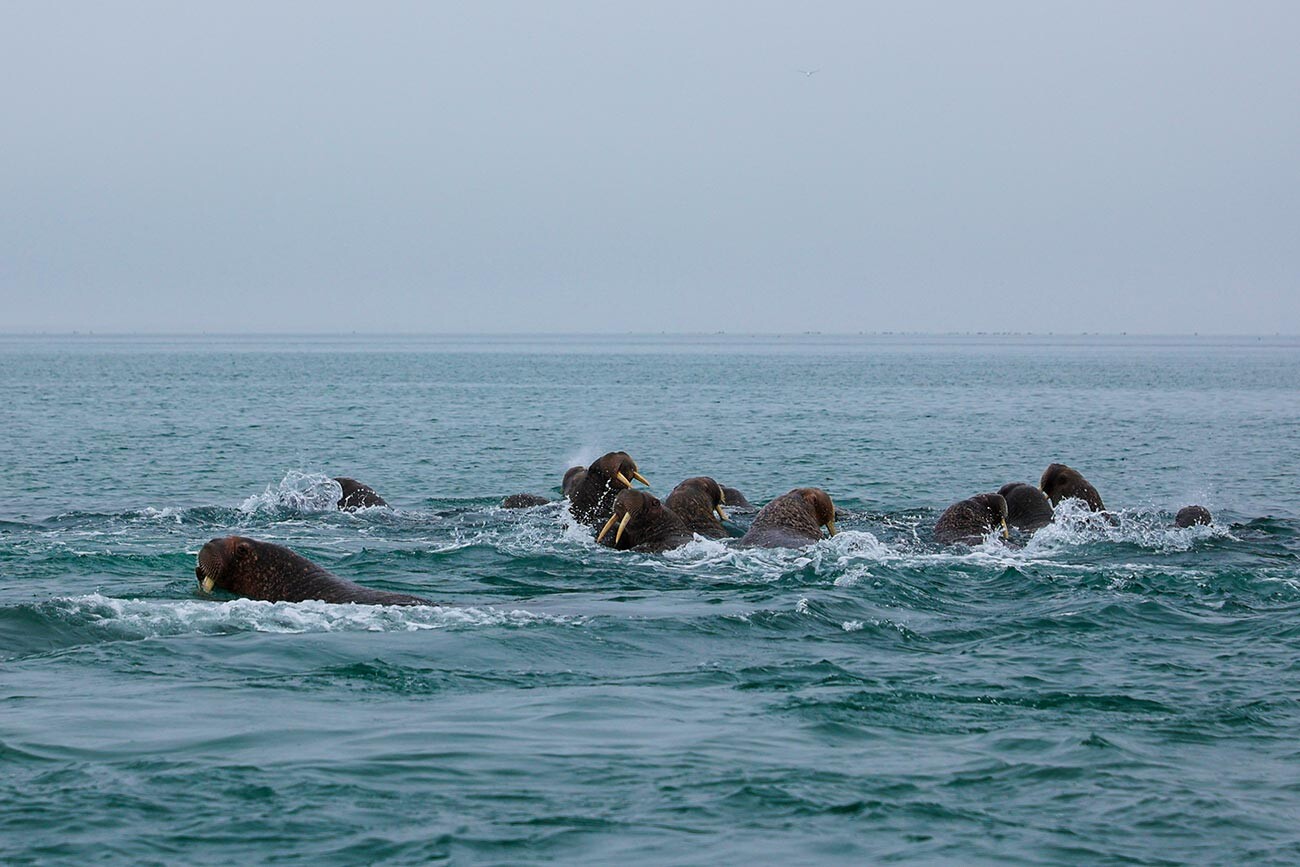
"Are you going to watch us?"
Right now, with regional support, the spit is seeing the construction of a modern tourist center, from which people will be able to watch walruses and whales.
4. Cape Dezhnev
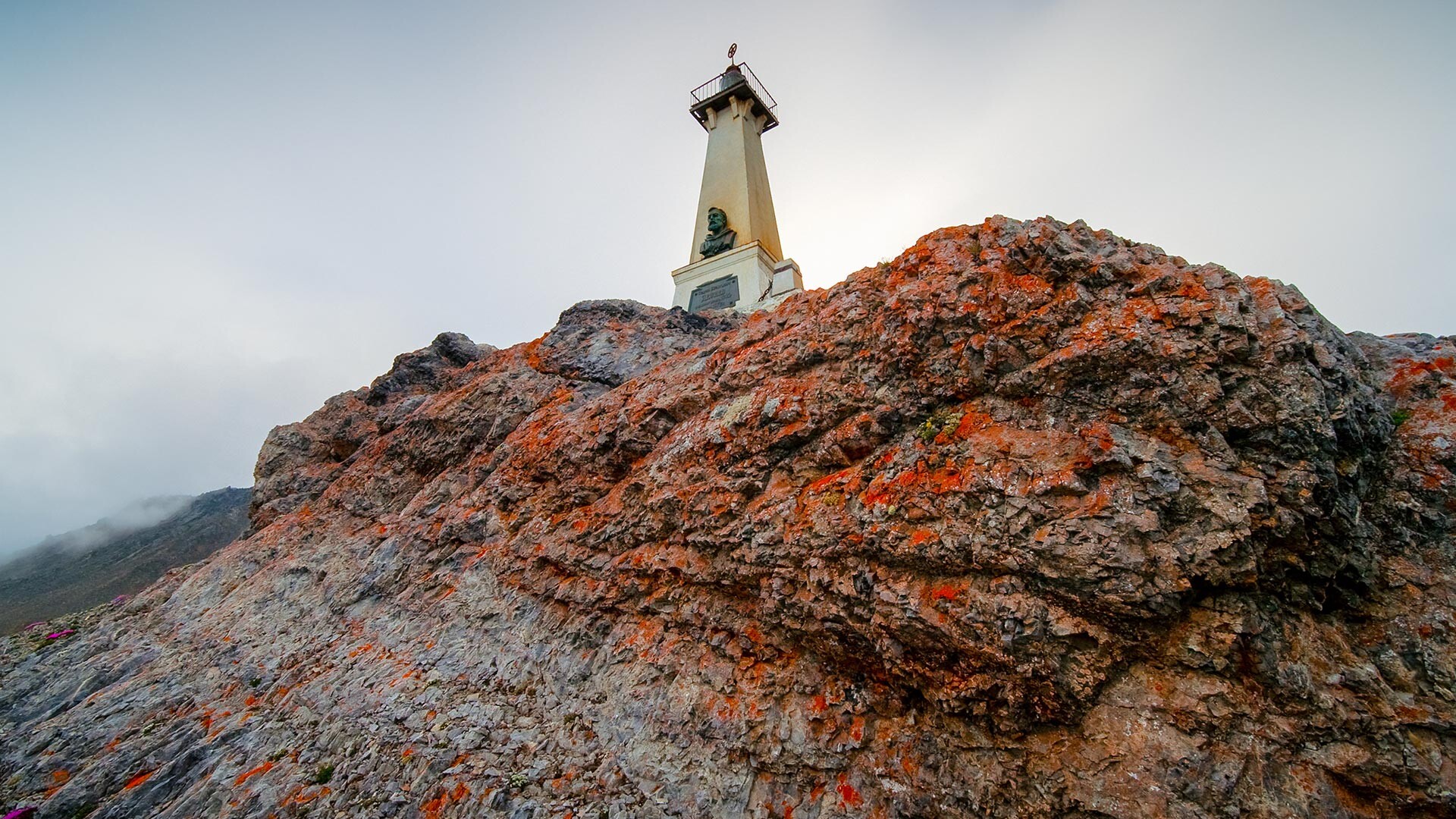
At the edge of the continent.
The edge of the world is just as you have always imagined it: a high rocky cliff, plunging steeply into the icy sea. Cape Dezhnev is the easternmost mainland point of Russia and of the entire Eurasia.
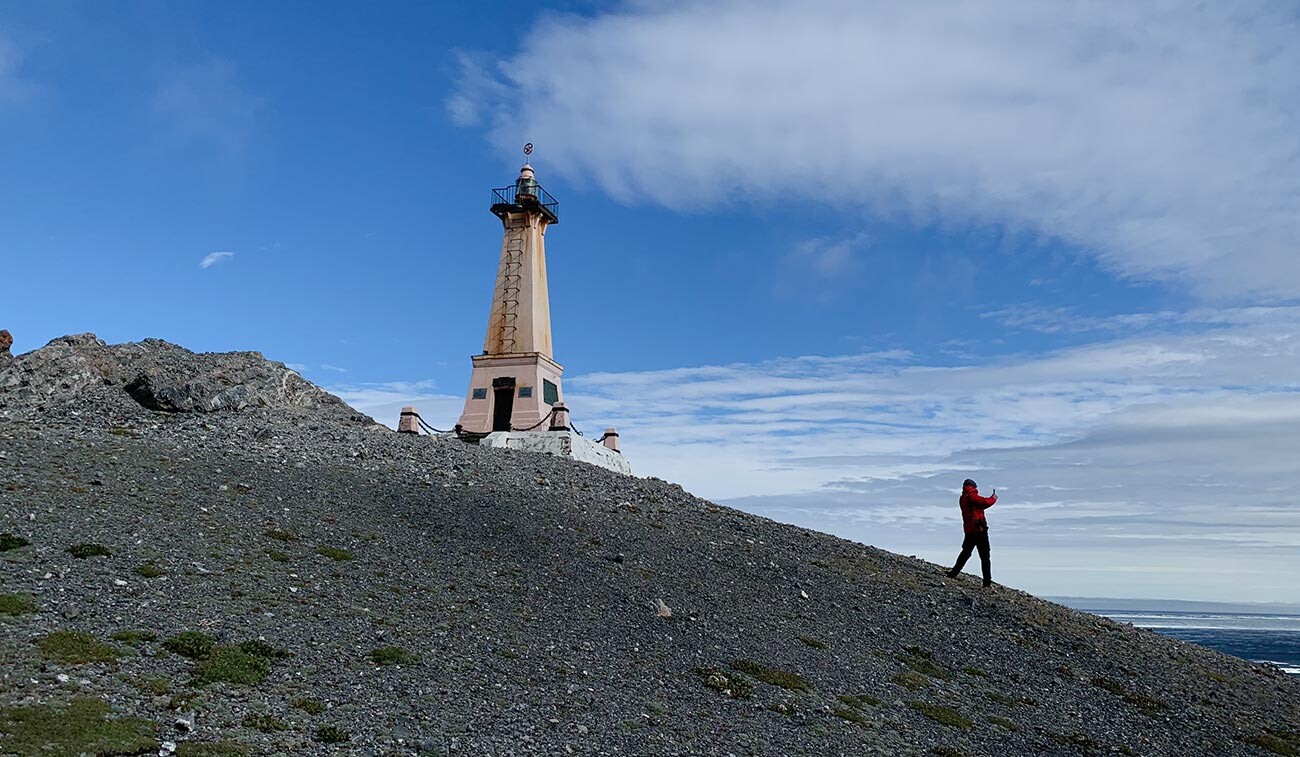
Cape Dezhnev
This is where you can find a lighthouse-monument to cossack Semyon Dezhnev, whose expedition was the first to reach the edge of the continent in 1648.
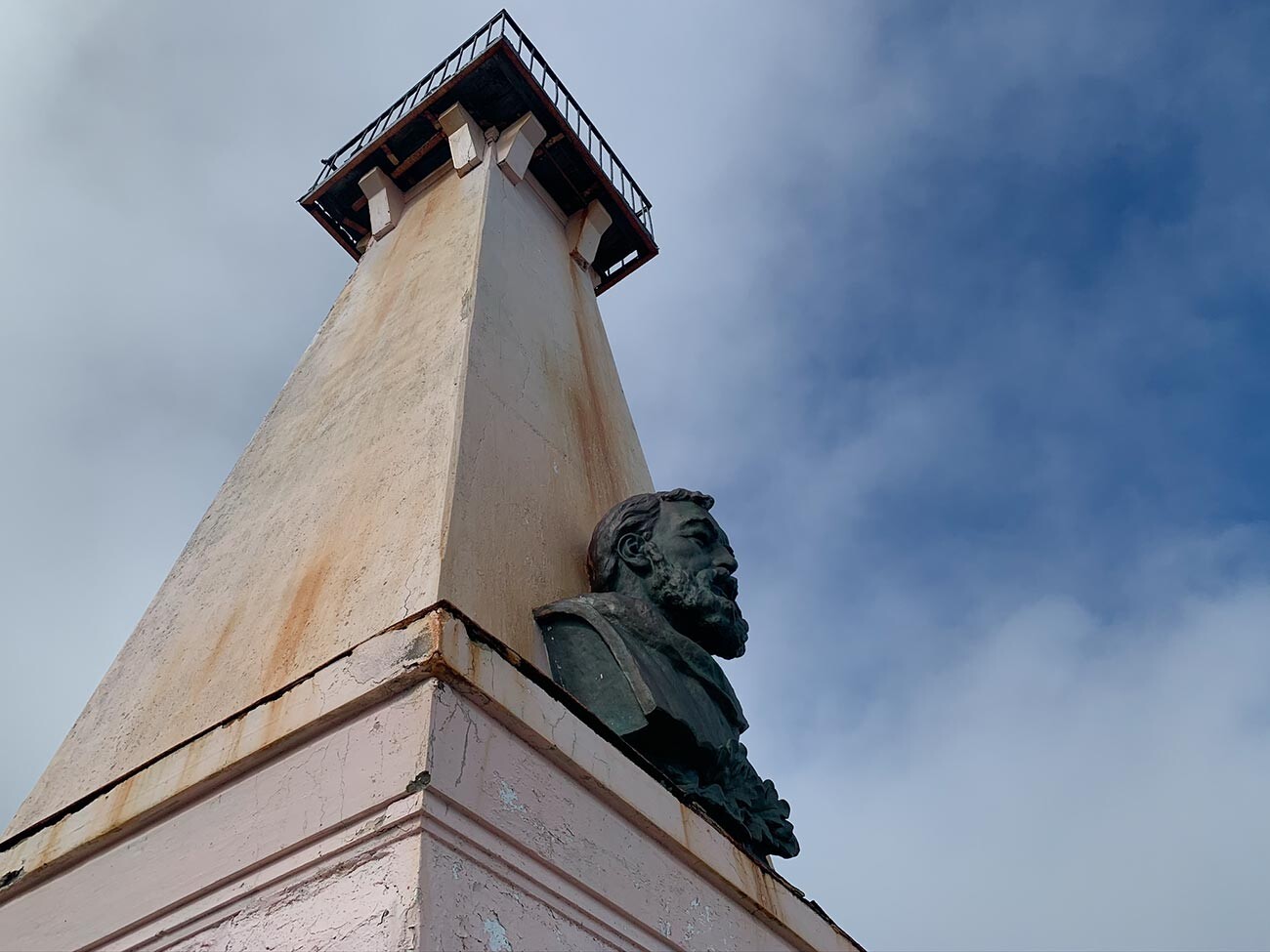
In clear weather, one can see the Diomede Islands from here through the Bering Strait; between them lies the border between Russia and the U.S.
5. The deserted village of Naukan
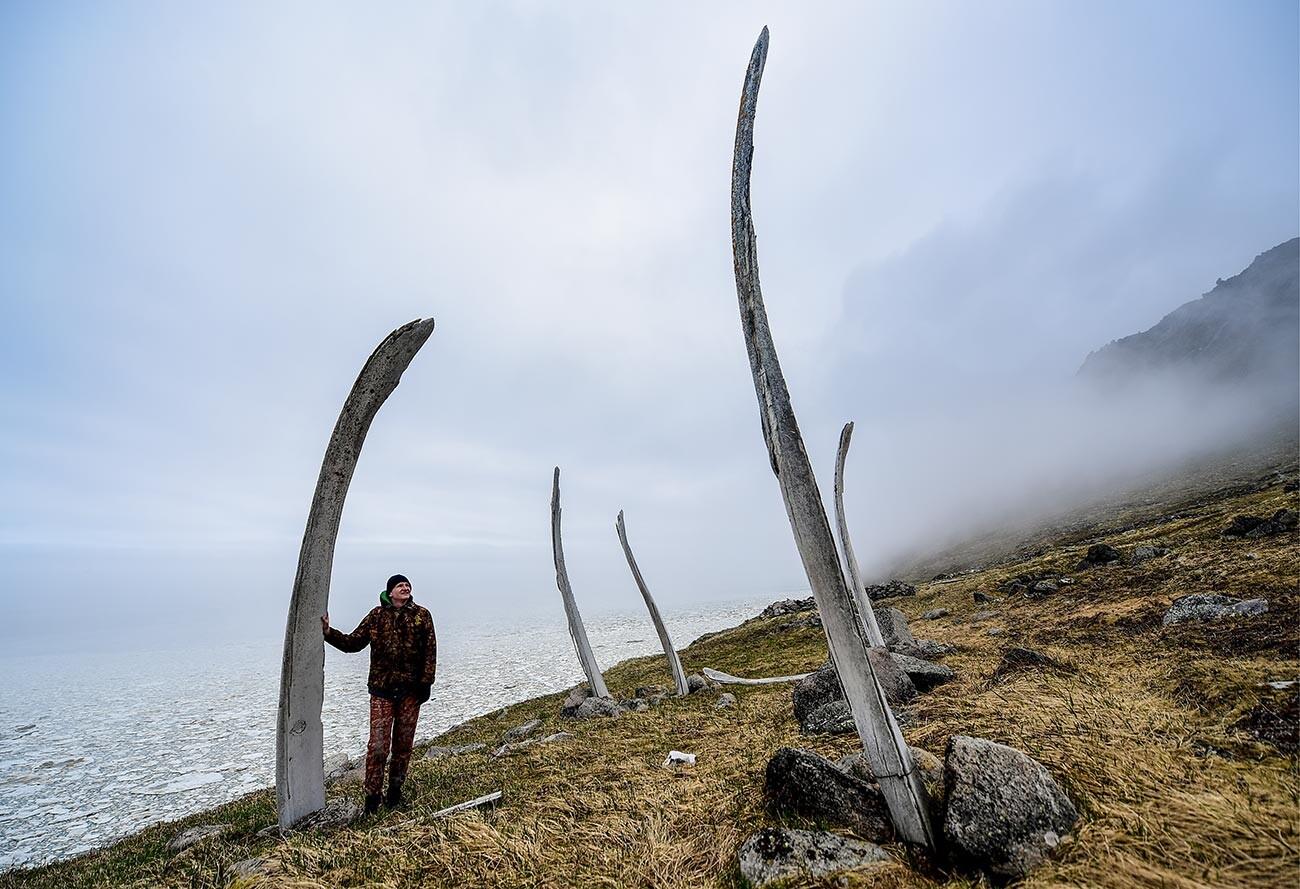
What a scale!
On Cape Dezhnev, you can spot the old Naukan Eskimo settlement, which held the honor of being the easternmost settlement until the middle of the previous century (now this title belongs to the village of Uelen , 22 kilometers to the West.
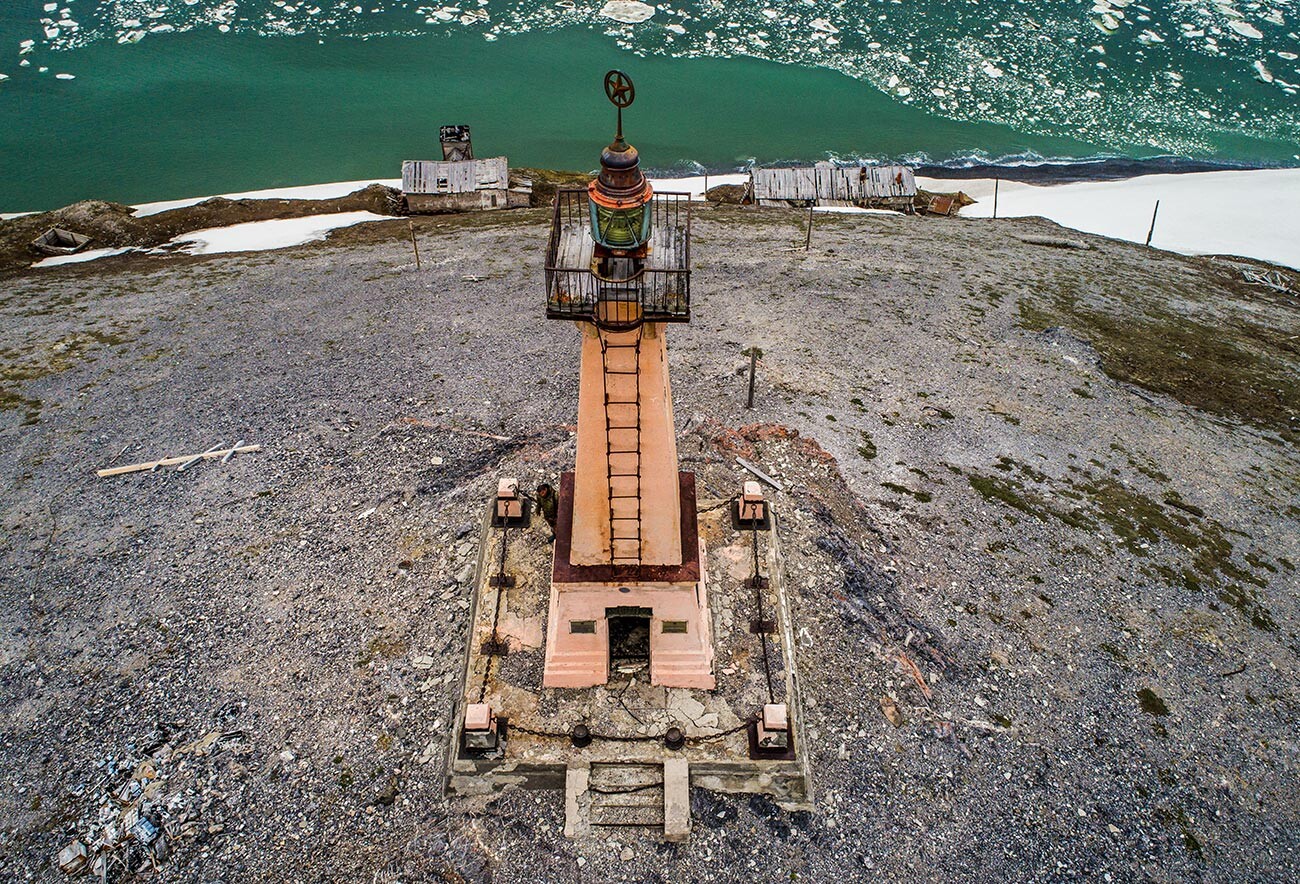
At the seaside.
Prior to its resettlement in 1958 (the village happened to be too close to the U.S. border), it had a population of about 400 people; now only stone ruins remain of their homes.
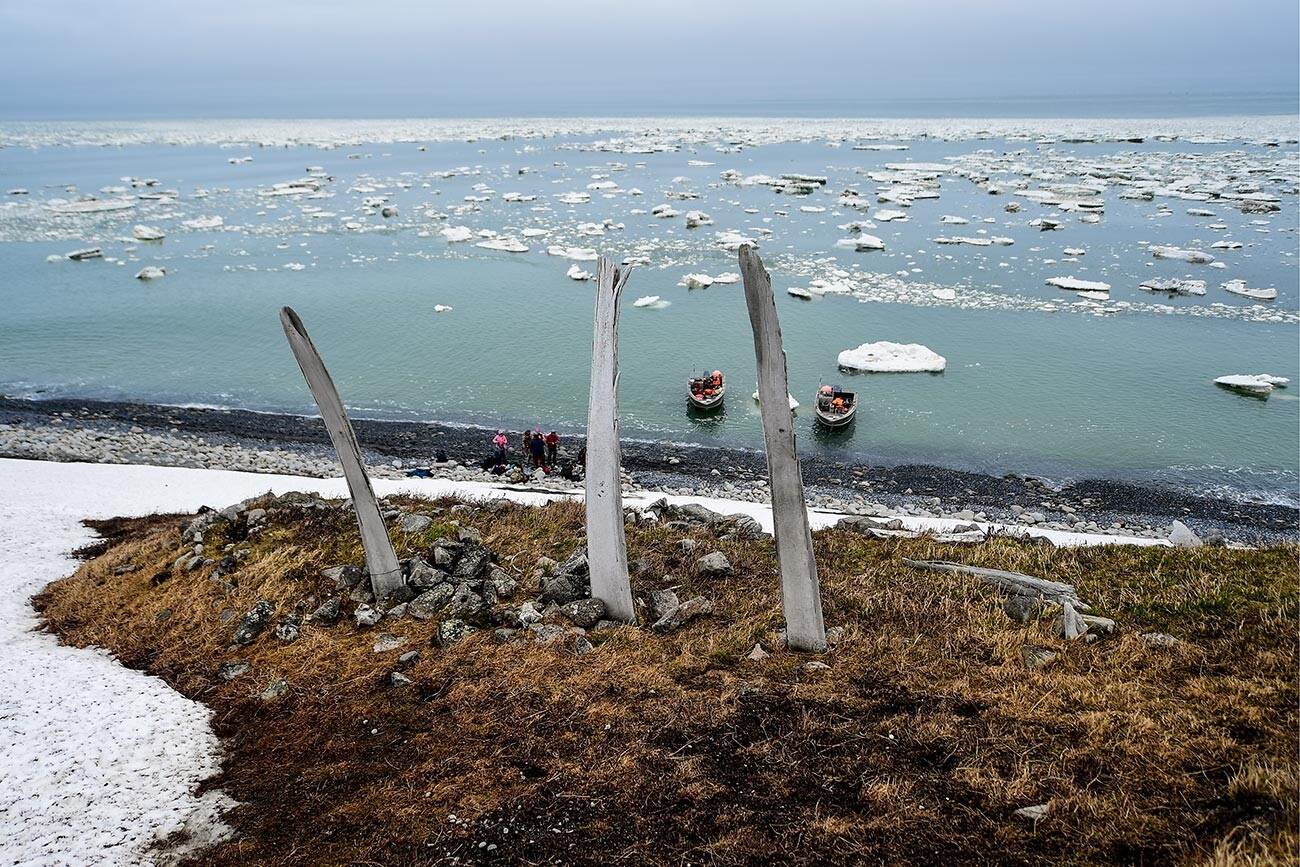
But the most impressive feature of this place are the giant whale jaws, dug into the ground, on which boats were hung in the past. These lands are considered sacred; you can’t swear there or even talk loudly.
6. The 180th meridian
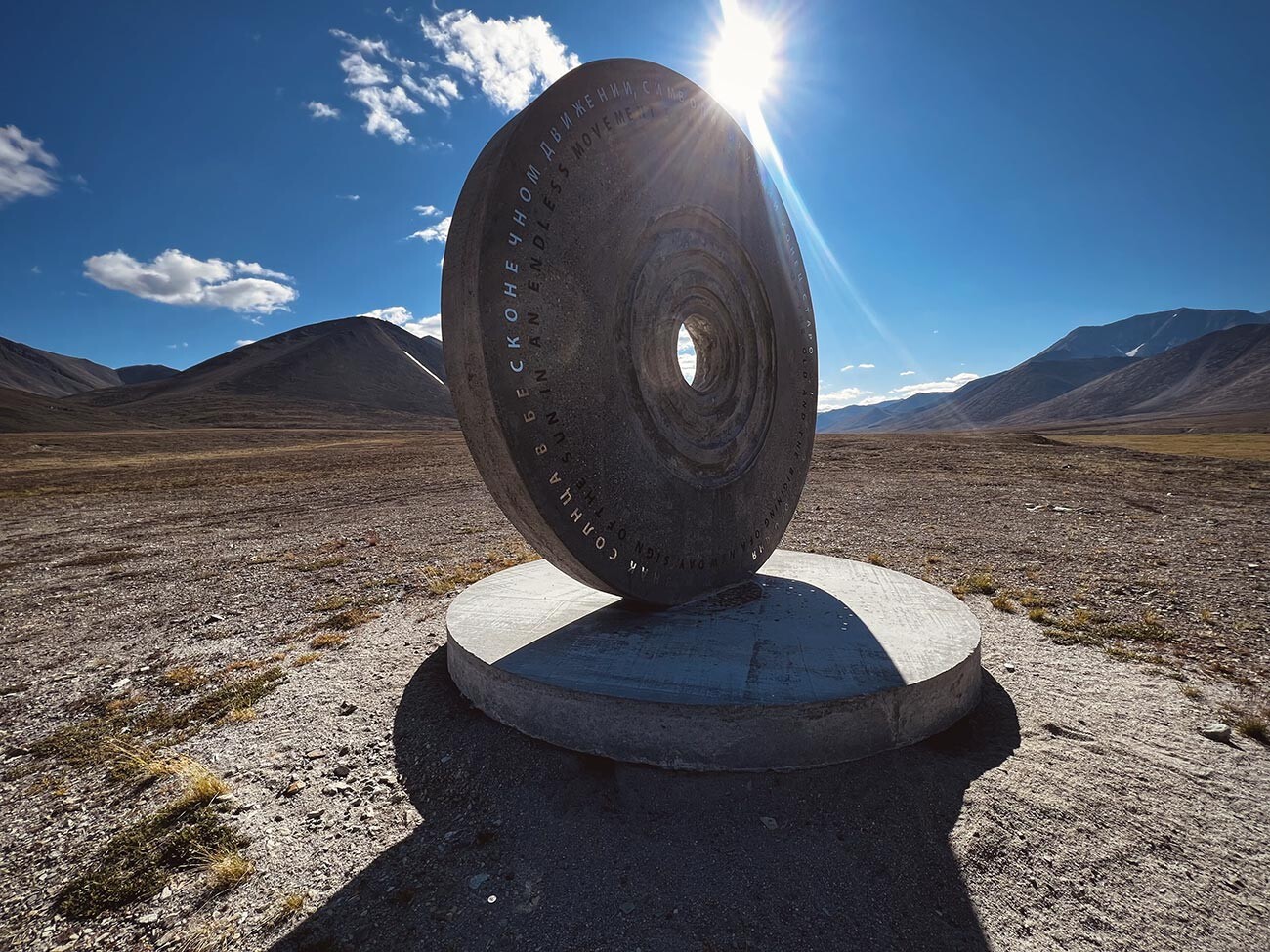
‘The Symbol of the Sun’ monument.
The meridian that separates “yesterday” from “today” (and also the Eastern Hemisphere from the Western Hemisphere) passes through land only in the Antarctic and on the Chukotka Peninsula. The official date line is shifted towards the sea border between Russia and the U.S., in between the Diomede Islands , but, geographically, it lies 60 kilometers away from the village of Egvekinot.
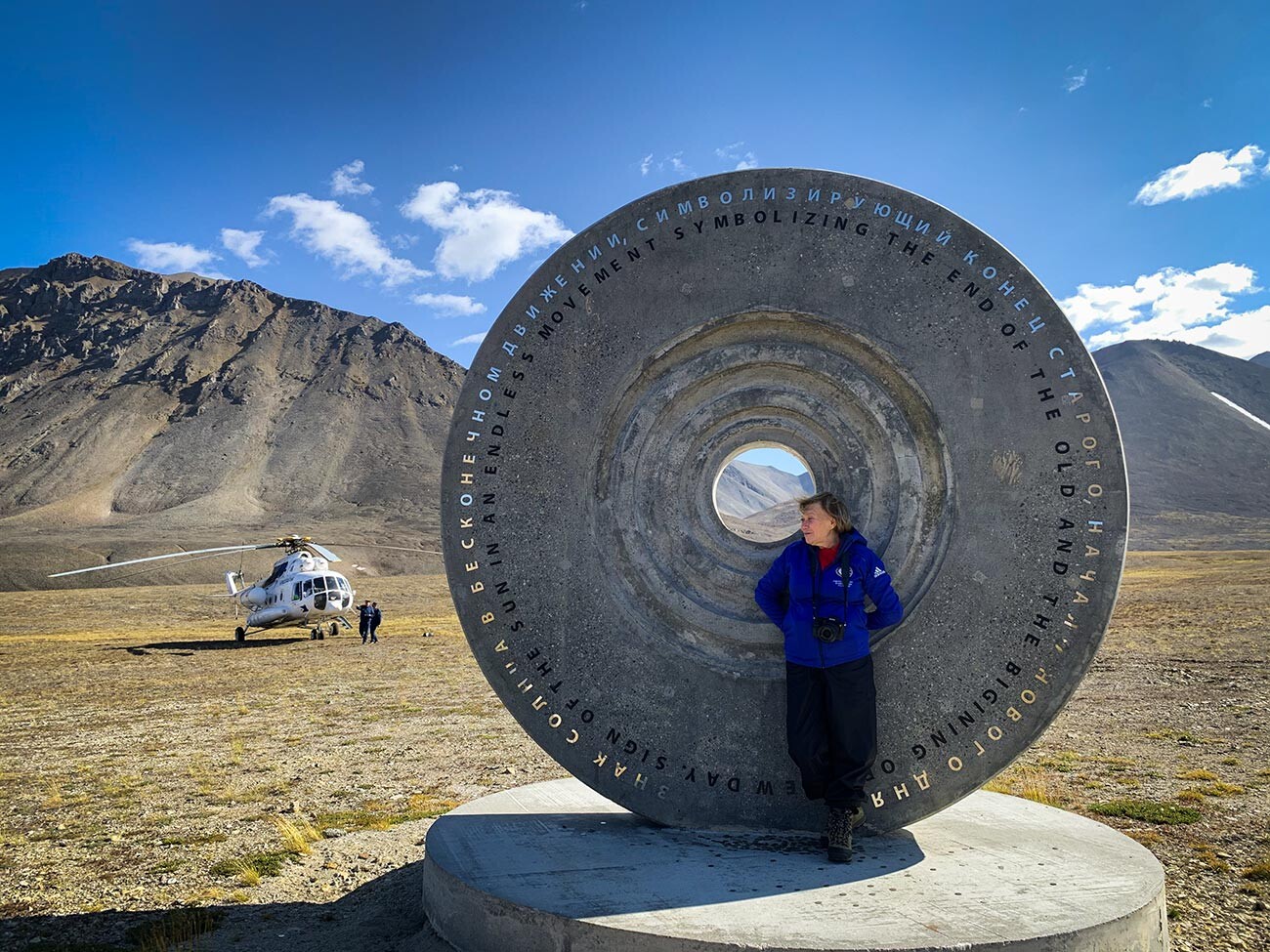
A concrete monument, ‘The Symbol of the Sun’, installed at the intersection of the Arctic Circle and the 180th meridian, is a small copy of the Sun. “It’s 400 million times smaller than the real star – just 3.48 meters in diameter,” Ida Taube , the photographer and author of the project, notes.
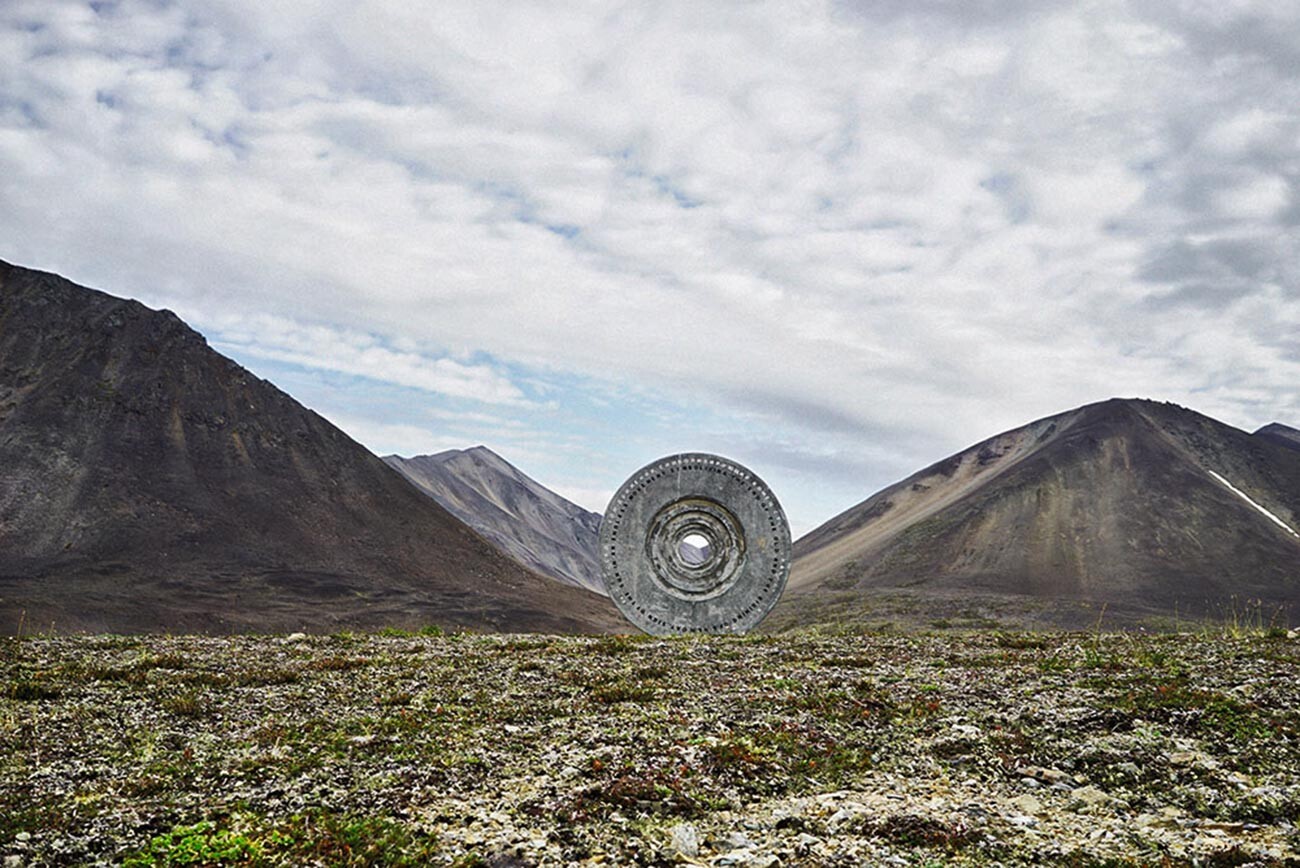
The place where "today" meets "yesterday".
“Today” lies on the hill behind the monument, and “yesterday” is right in front of it. How can you resist saying hello from “the future”... or the "past"?
7. The Arctic Circle Arch
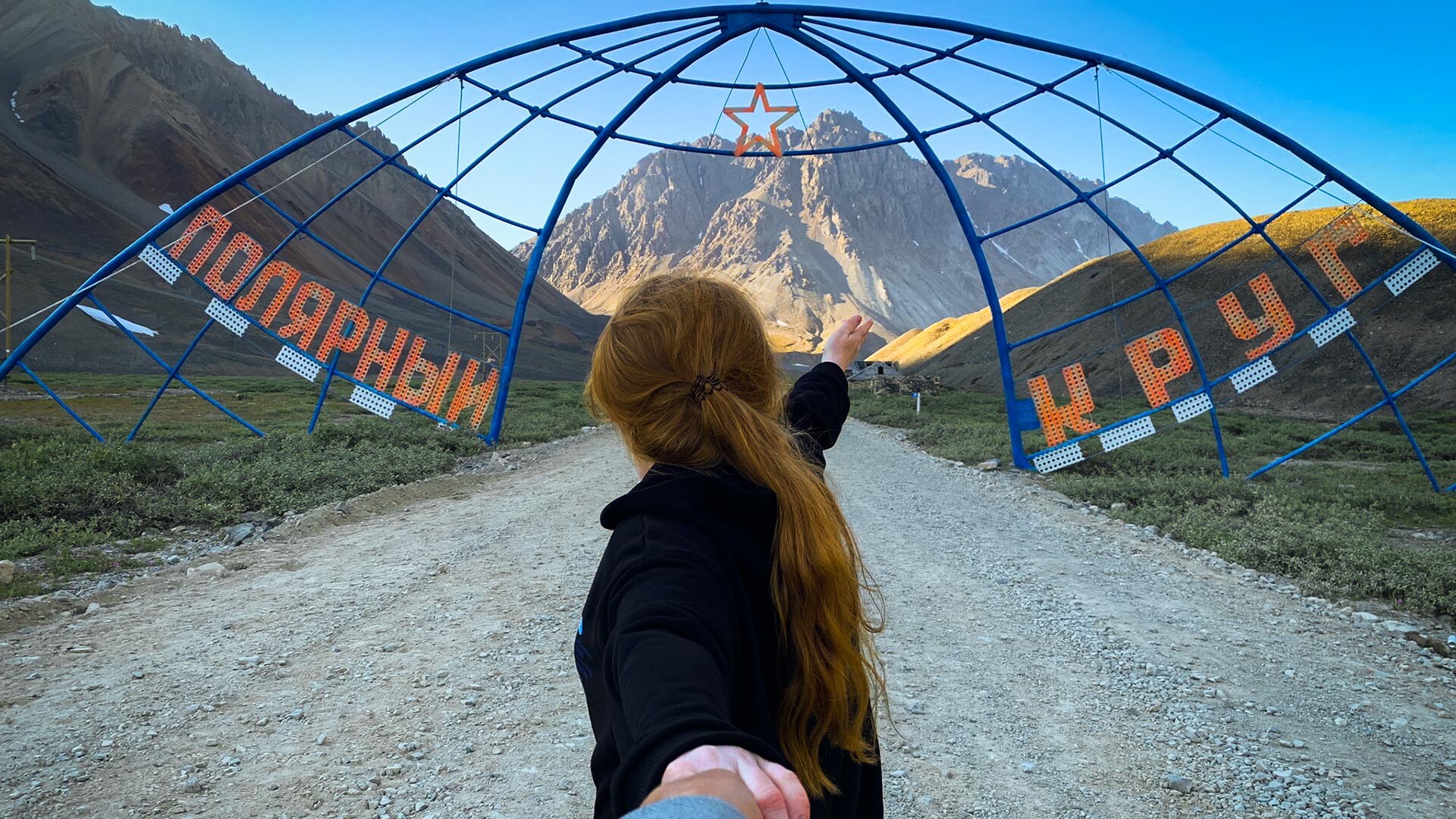
‘The Arch of the Arctic Circle’ was installed by locals in 1981, 28 kilometers away from Egvekinot. This colossal construction made of metal bars hangs over the route leading to the abandoned village of Iultin.
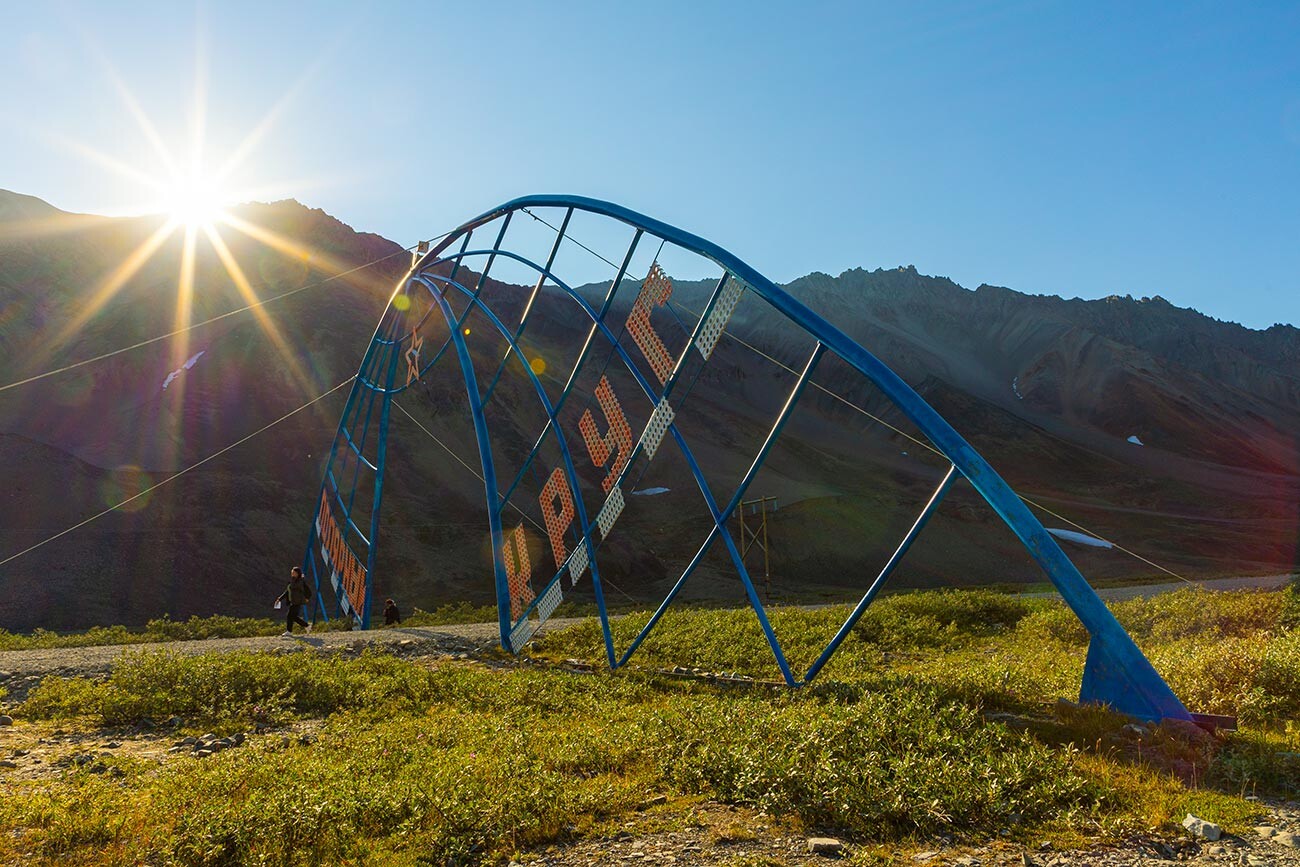
Several years ago, Russian geographers recalculated the coordinates and found out that the real crossing point of the Arctic Circle lies several kilometers away from the arch by this route, at the foot of a hill. However, it was impossible to move the arch there; instead, a memorial pillar was installed.
8. Egvekinot village
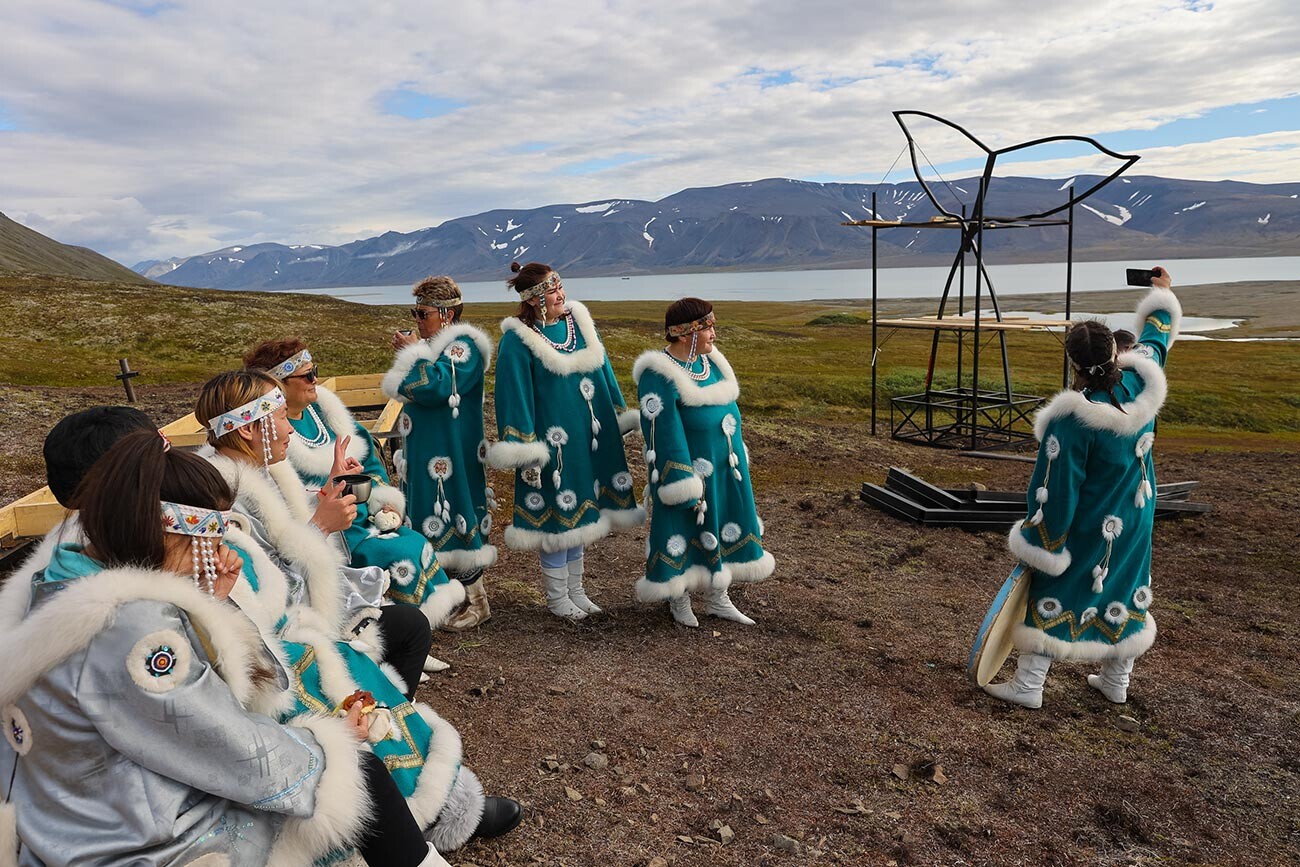
Construction of an ethnic park in the style of the ancient settlement of sea hunters near the village.
The village Egvekinot, 600 kilometers away from Anadyr, is dubbed ‘Chukotka’s Switzerland’ by the locals. This settlement (with a population of slightly over 3,000 people) is situated in a calm bay, encircled by a ring of hills.
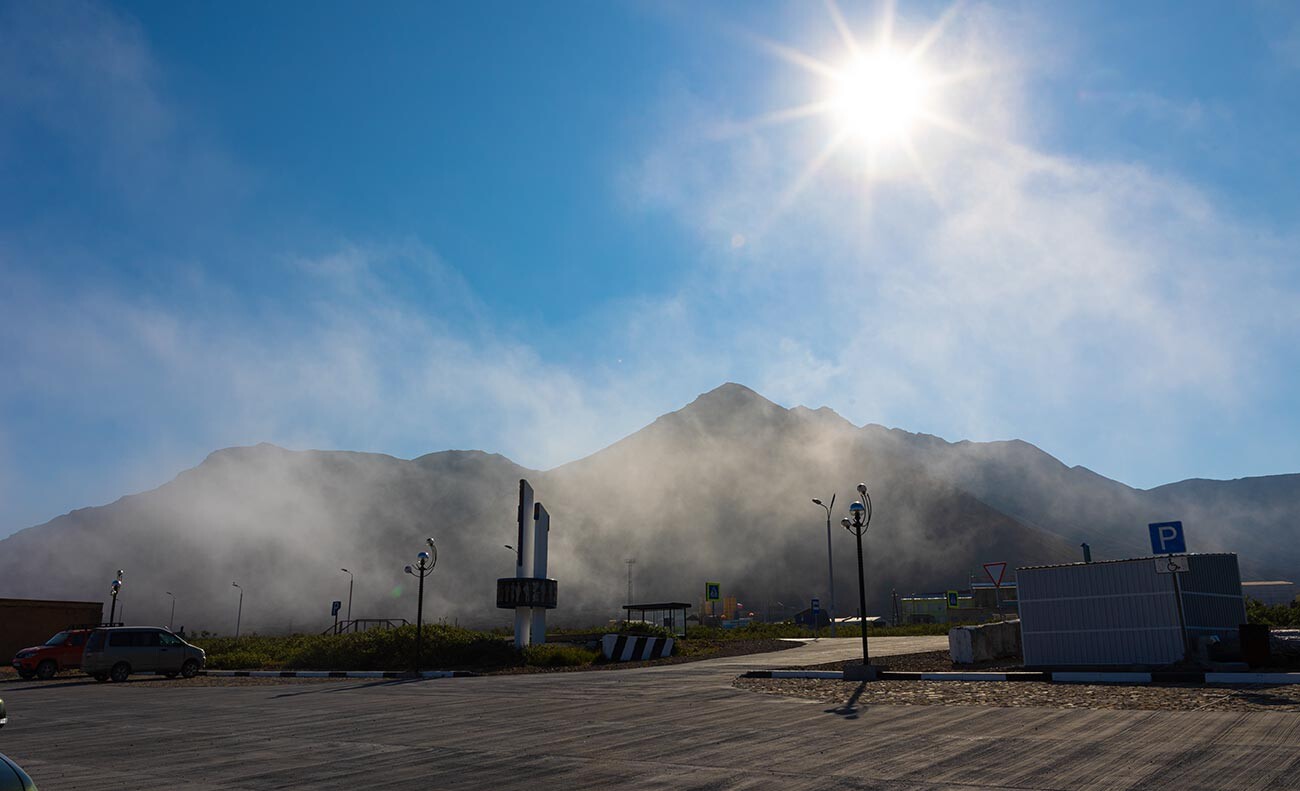
Foggy Egvekinot.
The landscape is truly reminiscent of that of the Alps, only with permafrost and a harsh climate: the average annual temperature here sits at minus 5 degrees Celsius.
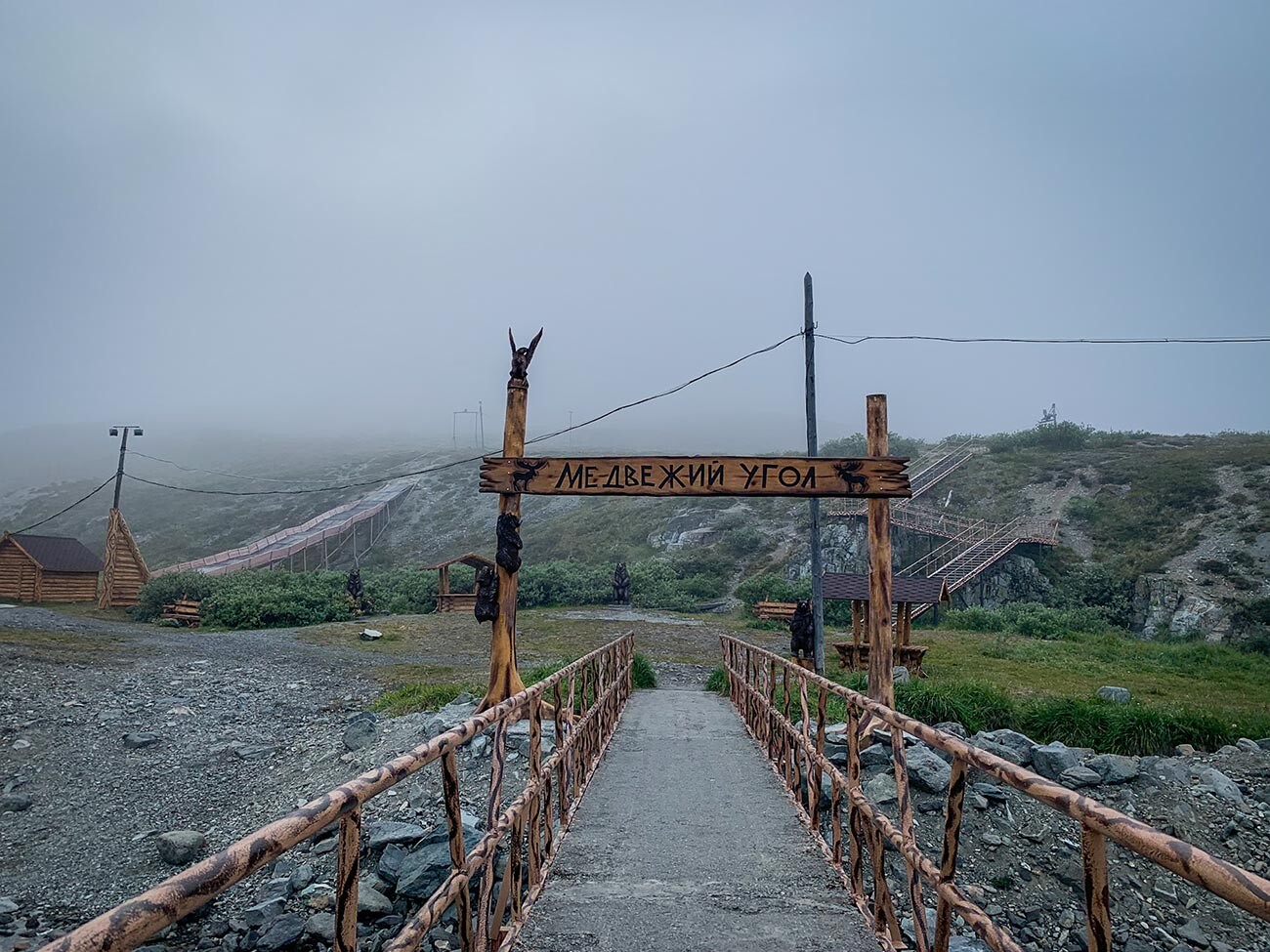
A ski point in the summer.
But, you can find a ski slope and decent cafes. It is also where you can experience the metamorphoses of space: Egvekinot lies several dozens of kilometers to the East from the 180th meridian; hence, geographically, you can step into the Western Hemisphere without crossing the Pacific Ocean.
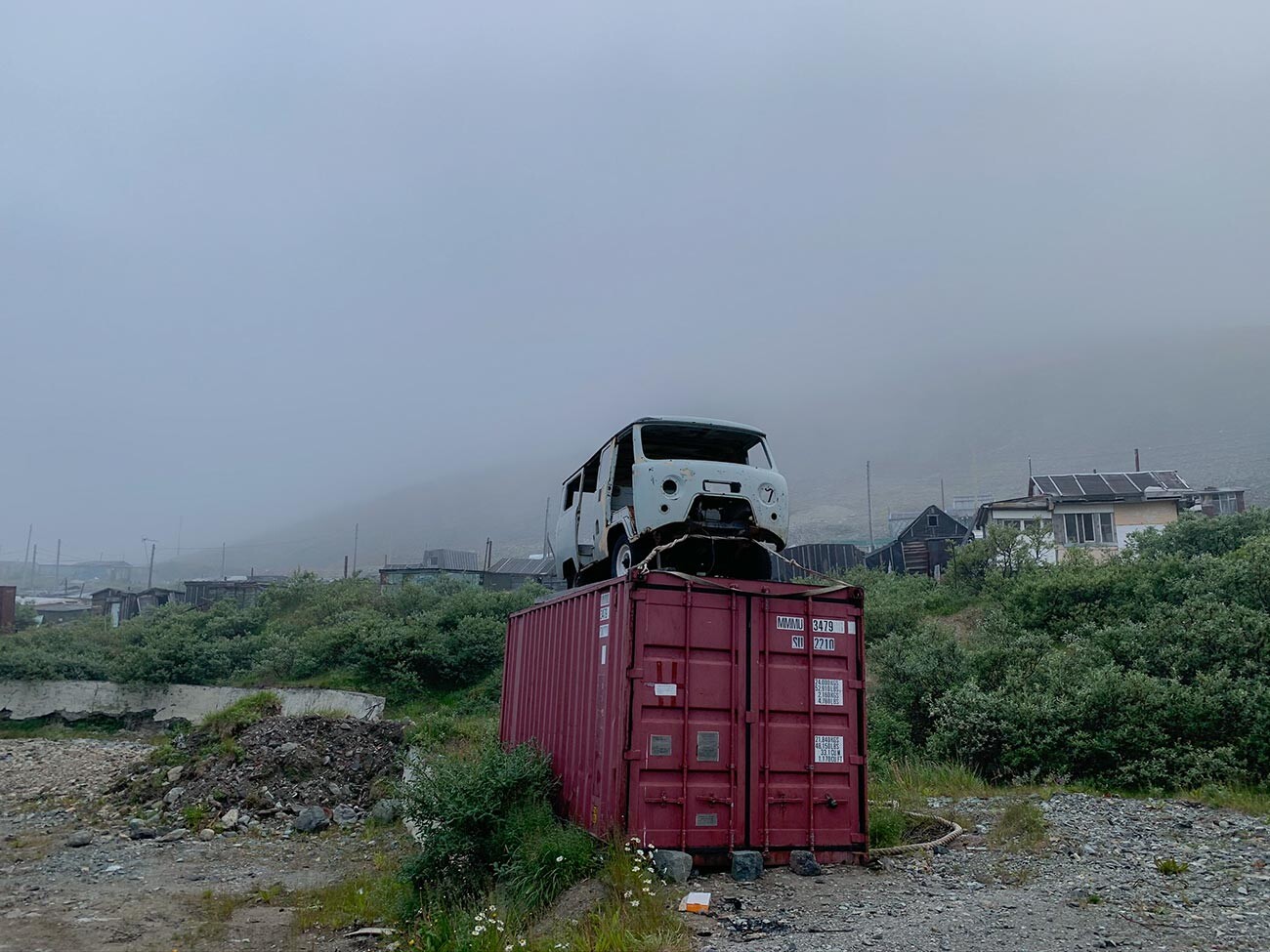
Authentic outskirts.
9. The national village of Lorino
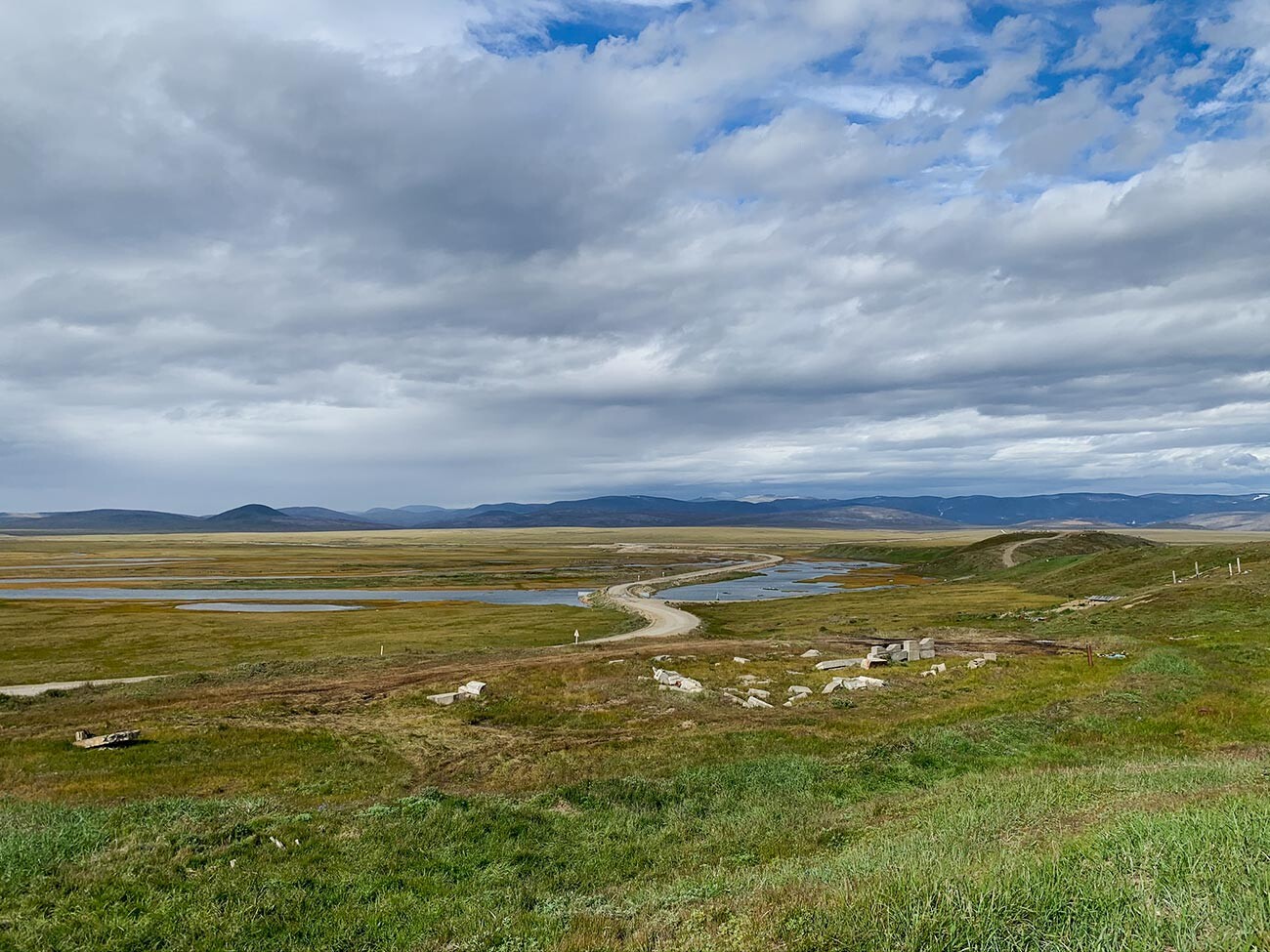
On the way to Lorino.
Lorino is the largest village in Chukotka, where about 90% of the inhabitants (out of 1,500) are indigenous sea hunters.
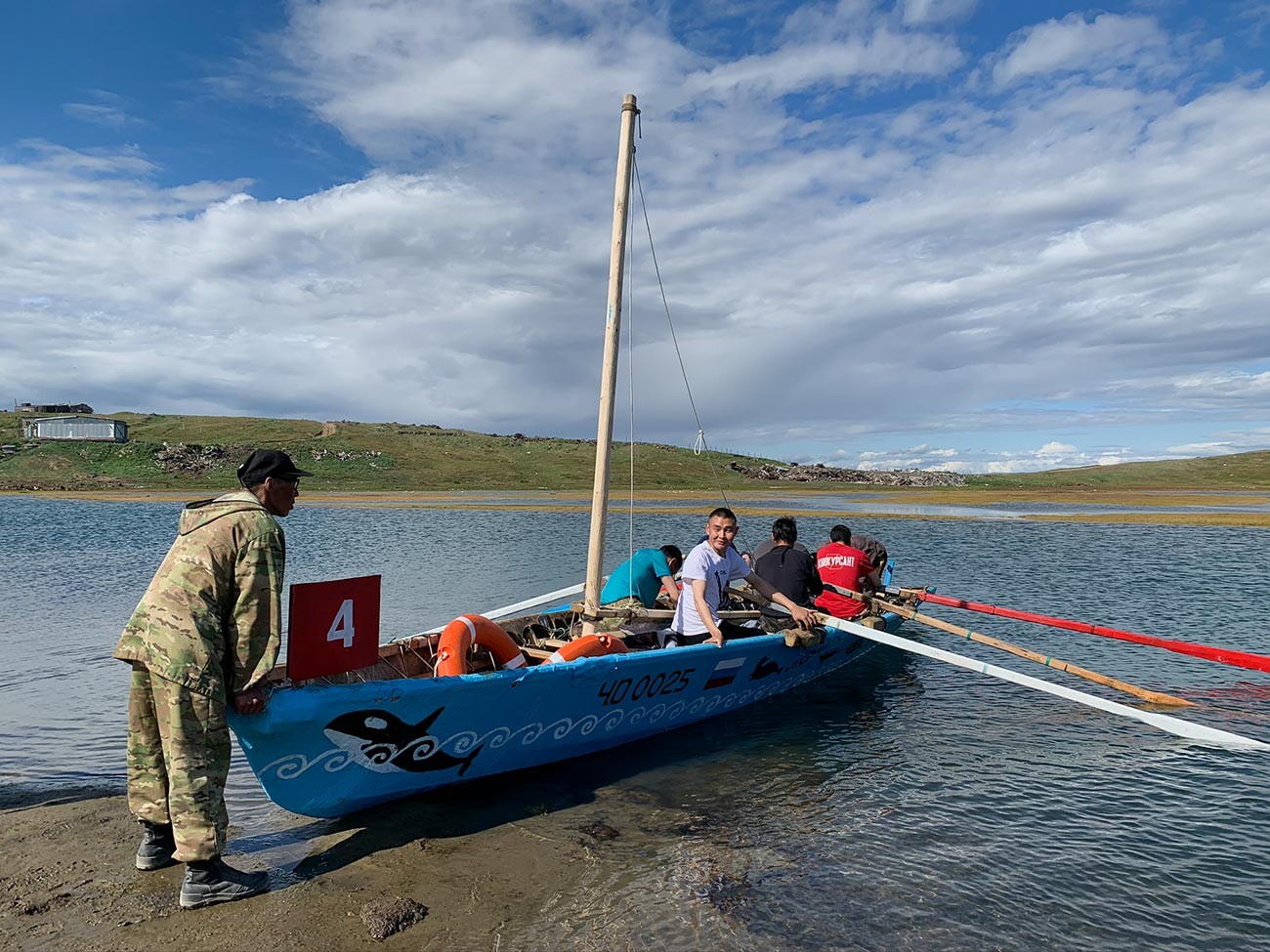
A regatta on traditional boats.
They live in regular apartment blocks, they watch satellite TV, their kids attend school like anyone else, but they also engage in the traditional hunt.
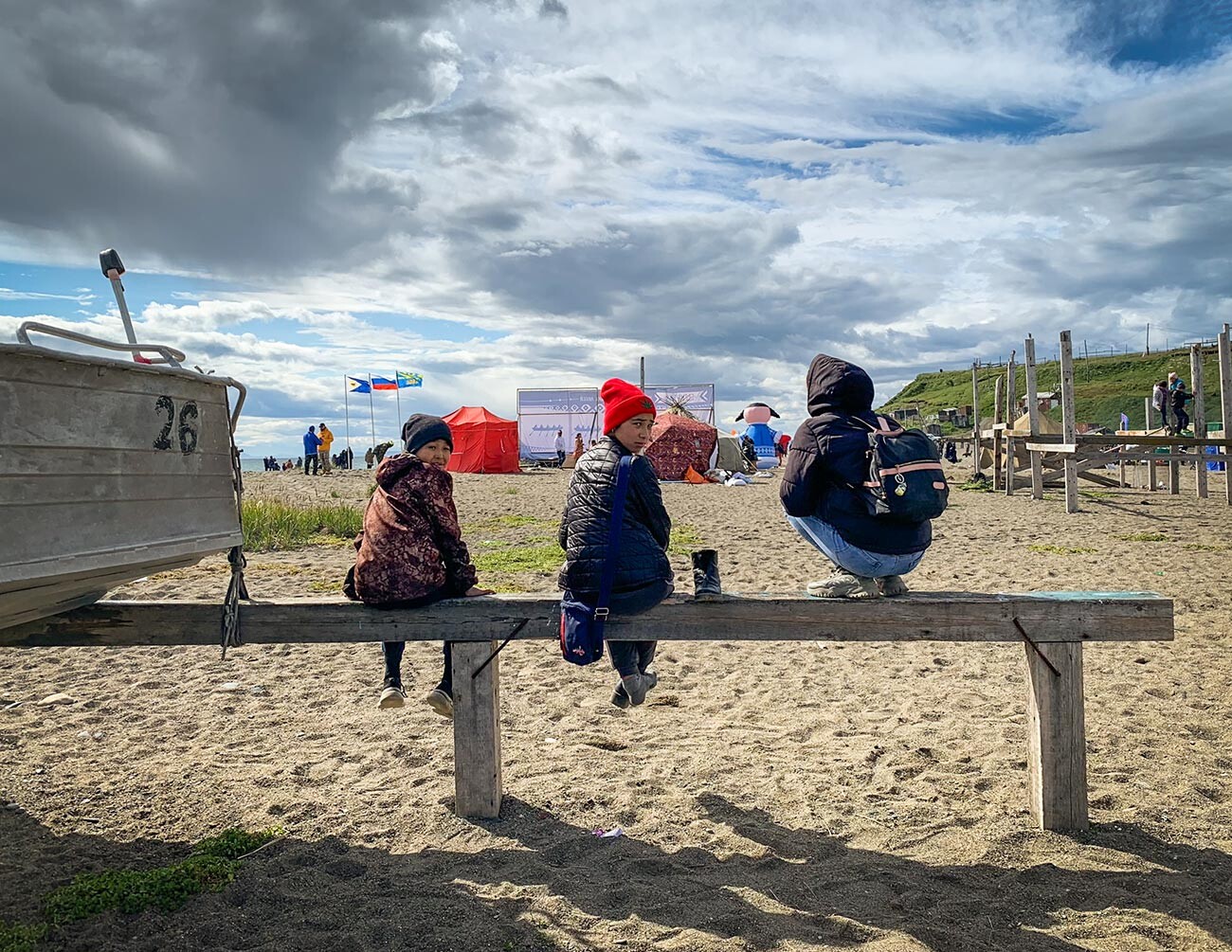
Guests at the Beringia festival.
The spoils of the hunt are then shared among the villagers. Today, the hunters sail the sea on modern boats, but, every summer, they hold self-made kayak sailing competitions and celebrate the Beringia folk festival.
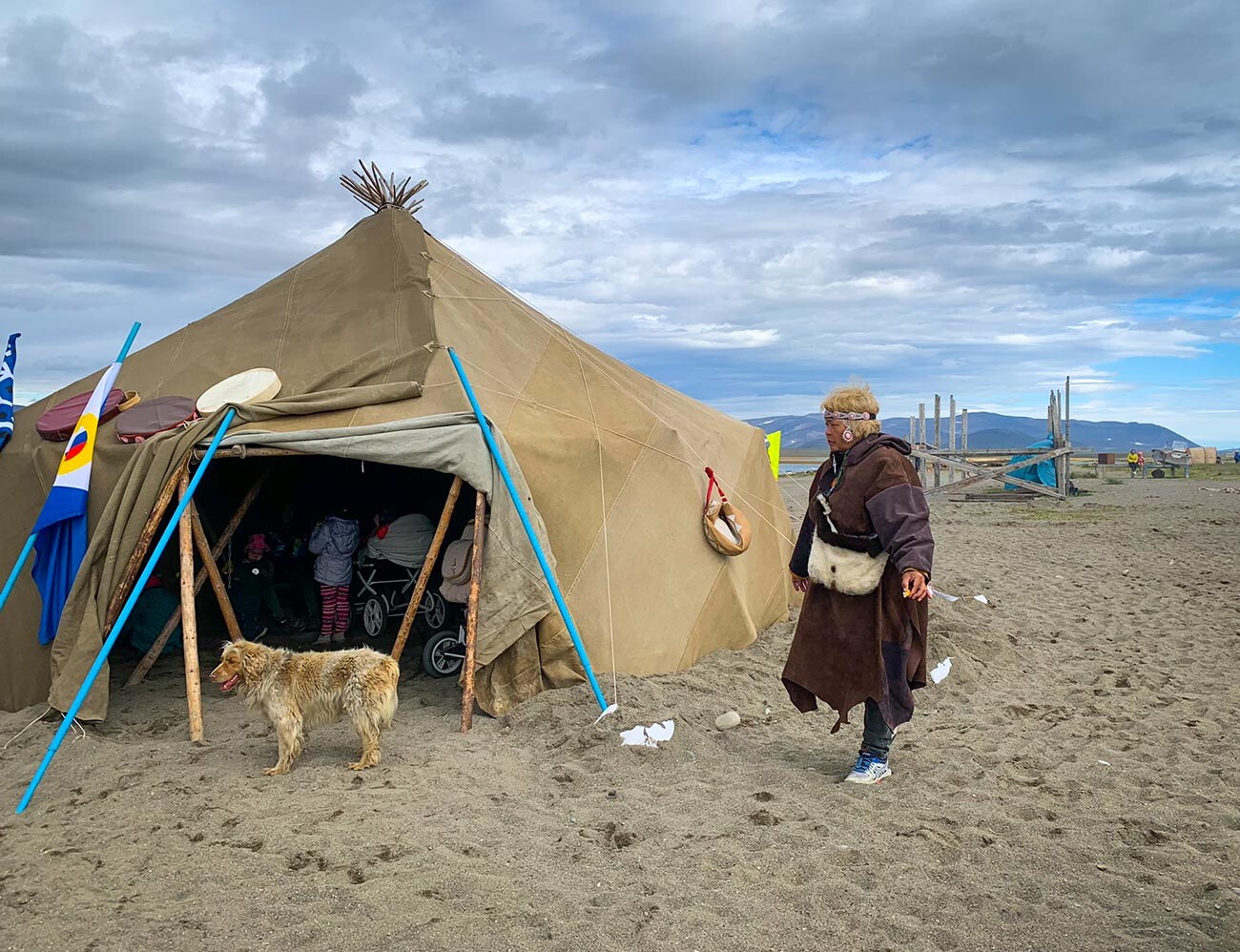
At the Beringia folk festival.
10. The Lorino hot springs
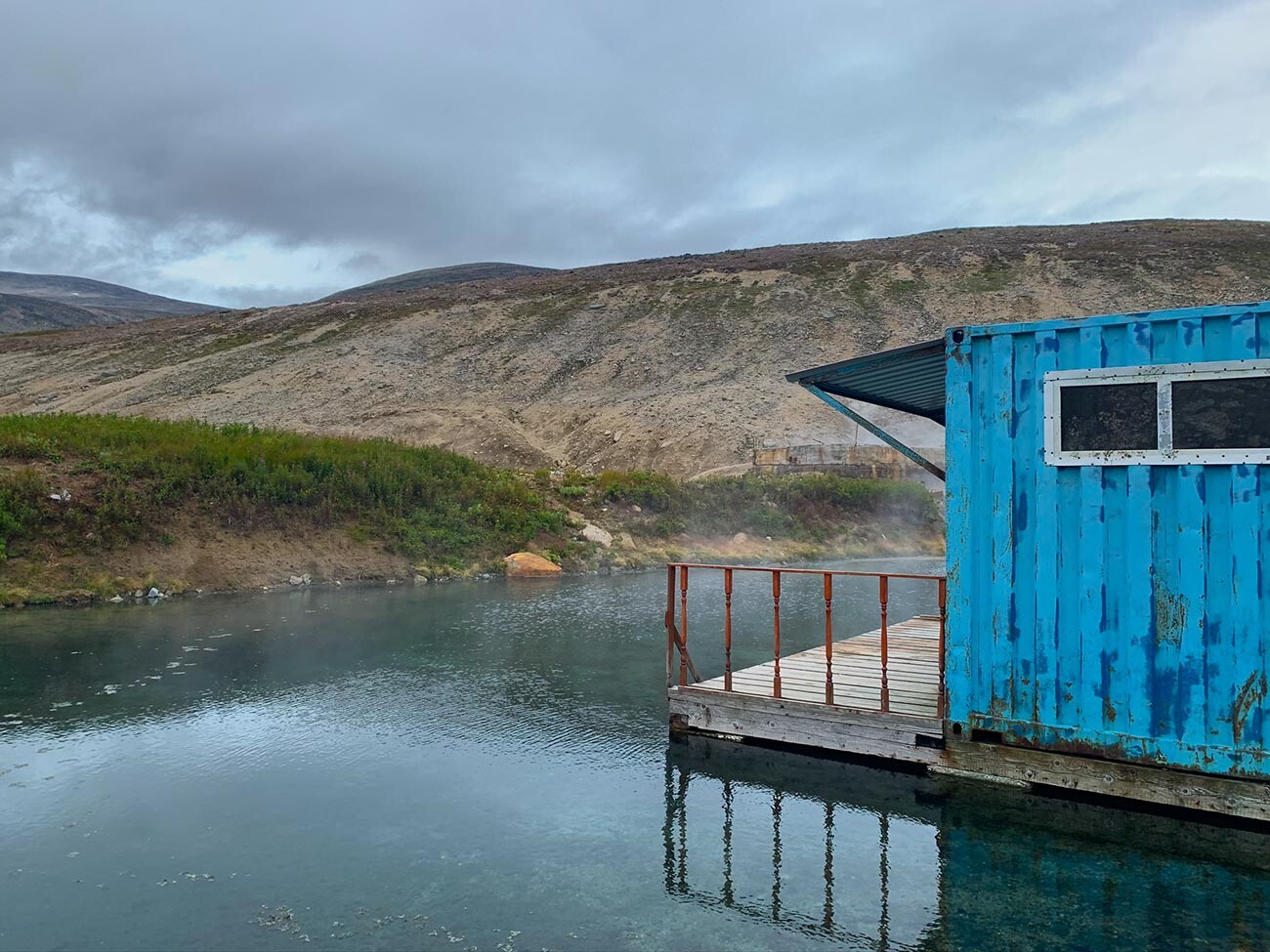
Look at the steam over the water!
Hot springs in permafrost – isn’t that a wonder? There are about 10 places like this in Chukotka, but the most famous and accessible one lies within 15 kilometers from Lorino village. Baths had been installed at the Lorino hot springs back in the middle of the previous century, but then radon was found in the water.

The water is really hot.
Radon is a radioactive gas that occurs as an intermediate step in the decay chains of uranium and has a range of potent healing properties. But, its radioactivity poses a threat for children and young people, so it’s most often used as an anti-aging remedy for the elderly, particularly in the treatment of the musculoskeletal system. The water temperature in the springs is about 40 degrees Celsius, sometimes reaching 60 degrees. You can enjoy this hot spring bath for no more than 15 minutes.
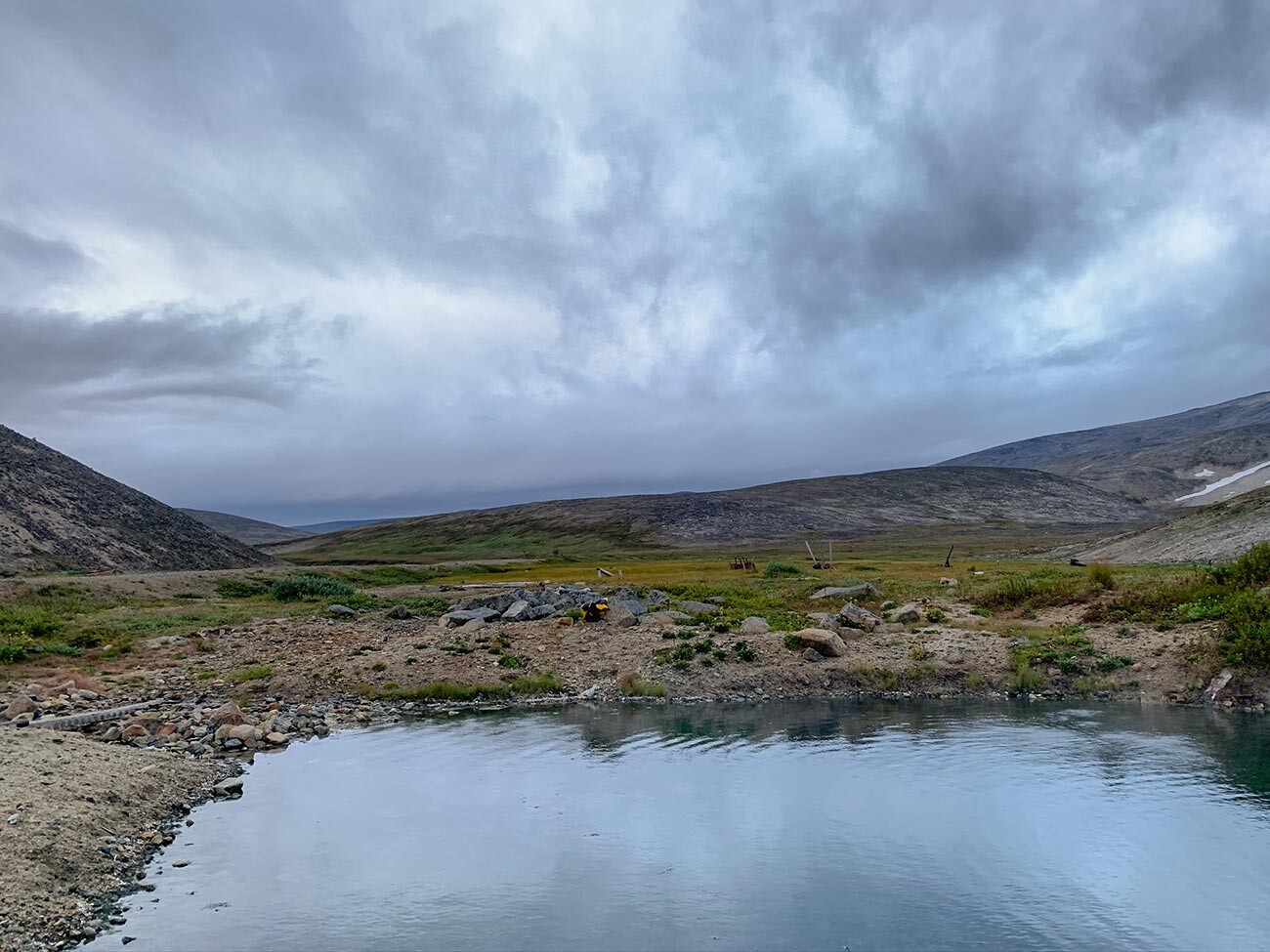
Hot springs with a tundra view.
Dear readers,
Our website and social media accounts are under threat of being restricted or banned, due to the current circumstances. So, to keep up with our latest content, simply do the following:
- Subscribe to our Telegram channel
- Subscribe to our weekly email newsletter
- Enable push notifications on our website
- Install a VPN service on your computer and/or phone to have access to our website, even if it is blocked in your country
If using any of Russia Beyond's content, partly or in full, always provide an active hyperlink to the original material.
to our newsletter!
Get the week's best stories straight to your inbox
- Exotic Chukotka life through the eyes of Ida Taube (PHOTOS)
- 25 magnificent Russian sunsets (PHOTOS)
- Elgygytgyn - Chukotka’s most mysterious lake (PHOTOS)
This website uses cookies. Click here to find out more.
First Class Tours
- About Our Company
- Our Services
- Get A Quote

Trustworthy Maintenance
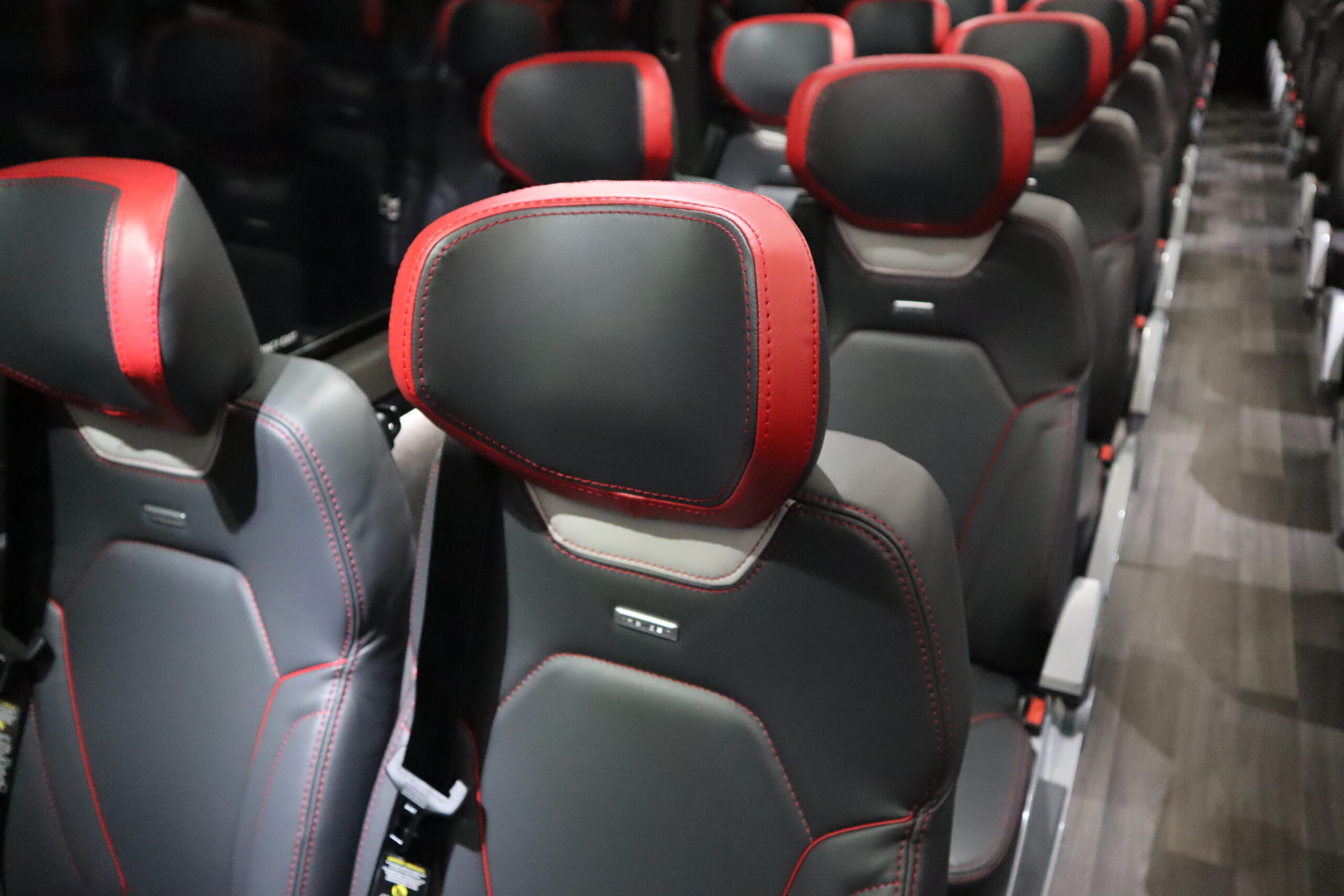
Leather Interiors

Professional Drivers

Power and Wifi Available

Professionalism. Reliability. Luxury.

Reliable Service

35 to 57 Passenger Coaches

Spacious Seating
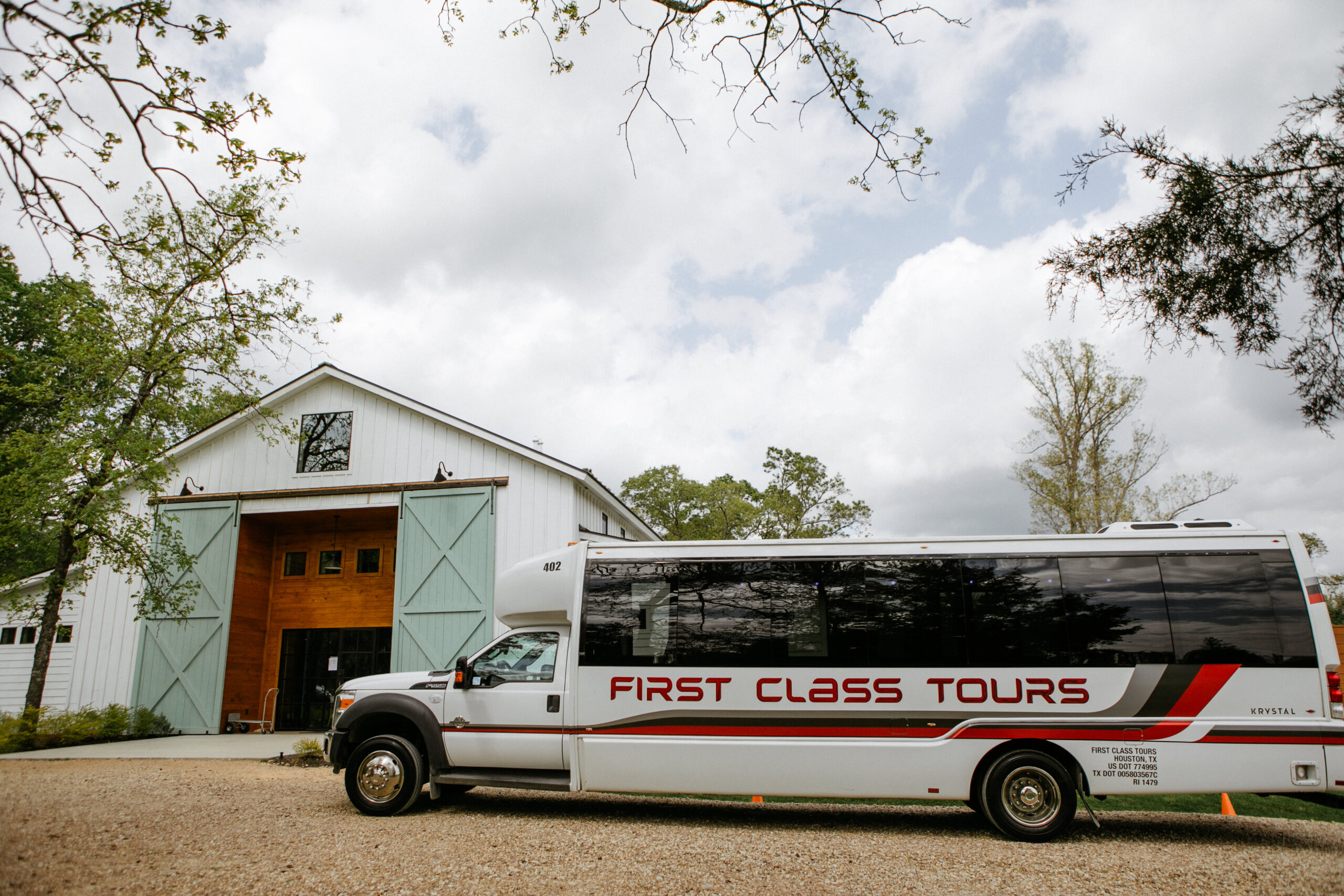
Mini Sized Motorcoaches

Executive Step On Coach

28 Passenger Luxury
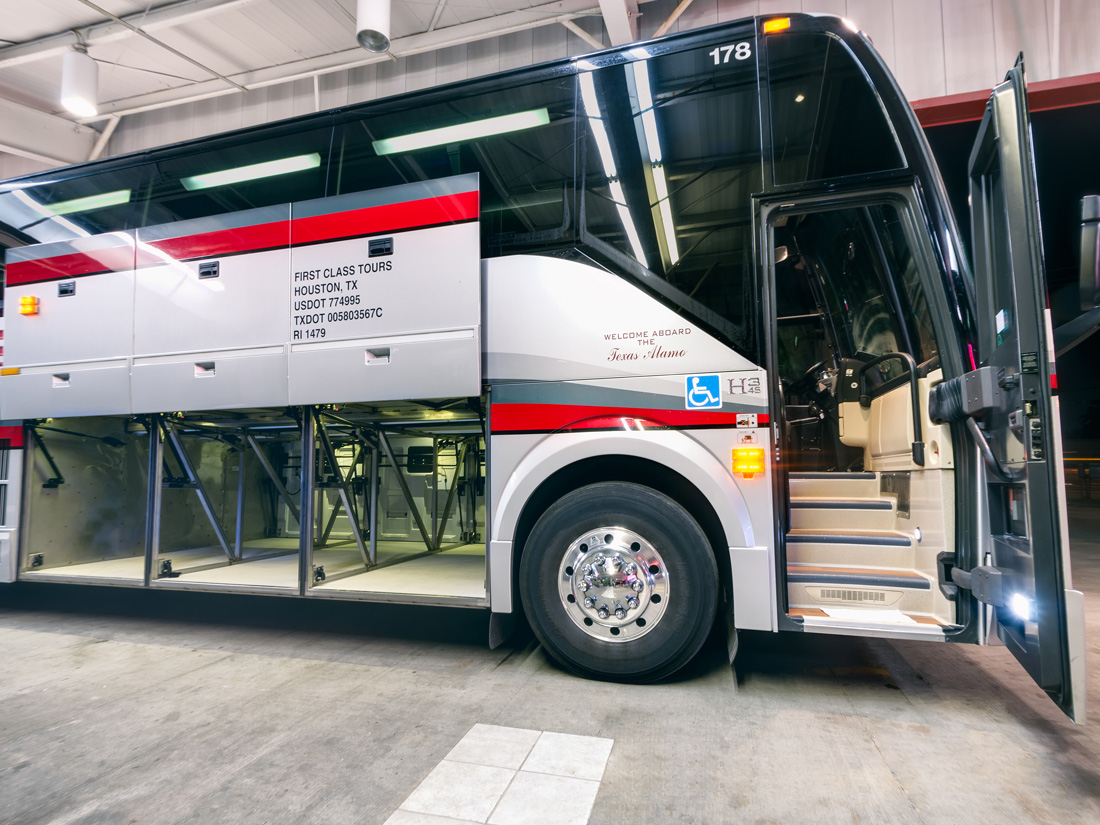
Under Carriage Storage

IMAGES
VIDEO
COMMENTS
First class of Swissair in 1960s. Life was once simpler. There was only one class for passengers on airline flights. Initially, it was a very 'adventurous' class - open cockpits and high rates of fatalities. It then evolved to become comparatively luxurious and ridiculously expensive, even extending to sleeper suites - thought of as a ...
Check this next picture out to understand the true extent of smoking at 35,000 feet. Yeah, that's right. The air hostess is doling out literal cartons of cigarettes for the passengers to choose from. It was a different world. Enjoy cocktails and cigarettes during your trip.
That was in 1968, when flying was a unique experience. The 1950's and 1960's were called the Golden Age of Flying, so-called because of the glamorous stewardesses, great meals (sometimes gourmet meals) and lots of legroom. Men wore three-piece suits and ties, ladies wore dresses, high heels and jewelry. A far cry from today's flights and ...
First class flights in the 1950s. The first stop on our journey is the 1950s, when commercial aviation really started taking off. On first class flights, the adventure actually began on the ground — with passengers receiving VIP treatment even before boarding. Imagine being escorted to a private lounge, complete with plush seats, cocktails ...
I, Pastor Titus Stewart, along with the Greater Emmanuel Family Worship Center Board of Trustees and the church membership, wish to thank First Class Tours, Inc. and your staff for excellent service. Our church recently charted a motorcoach with your company and we wanted to express that our driver, whose name is Gustabo, was an excellent ...
On behalf of T.E.A.M., we would like to "Thank You" for assisting with our company bus trip to Fiesta Texas on Saturday, August 17th. The drivers were very professional and they made everyone feel comfortable on the bus ride there and back. Again, thank you and we are looking forward to using First Class Tours for our next event.
Extremely racist. There's another unpleasant side of flight in the 1950s and 1960s that tends to be glossed over. "I think it's important to point out that in the Golden Age of Flying, only ...
Air travel had an image of glamour and excitement in the 60s. Air travel was for the rich and famous. The 1963 film "The VIPs" tells the story of a group of wealthy people stranded at Heathrow by bad weather. As well as Harry Palmer, the most famous 60s spy, James Bond, travelled by plane to Jamaica (in "Dr No") and Miami (in "Goldfinger").
In 1960 Trans-Atlantic Steamship Line services from New York to Europe were still going strong with almost daily sailings - Starting at $412.50 one-way first class on the Queen Mary or Queen Elizabeth. Posted by: Michael Grace May 21, 2008
We Started on August 17, 1960. Day 1. We left Long Beach, CA at 4:30 am, hoping to reach Oak Creek Canyon (near Flagstaff, Arizona) in time for a late picnic lunch. It was cool through the heart of the Coachella Valley. At 6:16 am, when the sun rose, the desert was beautiful.
310 FM 1960 Rd Houston, TX 77073 Open until 9:00 PM. Hours. Sun 7:00 AM -9:00 PM Mon 7:00 AM ... First Class Tours is a premier group charter bus company based in Houston, TX. With a fleet of top-of-the-line motorcoaches, they offer luxury transportation services for various occasions, including casino trips, daily and overnight trips, business ...
Anadyr is a port city in the extreme north-east of Russia, an administrative center of Chukotka autonomous okrug. The city is located in the permafrost zone, on the shore of Anadyr Bay in the Bering Sea. The population of Anadyr is about 15,000 (2022), the area - 20 sq. km. The phone code - +7 42722, the postal code - 689000.
Paragon Casino Trips. Paragon Casino Overnight Escape Starting from: $65 pp dbl occup. Paragon Casino 2-Night Getaways Starting from: $120 pp dbl occup. Book Now!
1960 45. Spring, TX 77381 +1 (281) 443-1200. ... Whether it's a corporate event, school trip, or private excursion, First Class Tours aims to meet the transportation needs of their customers with professionalism and efficiency. Their commitment to quality service ensures a pleasant and stress-free travel experience for all passengers.
First Class Transportation · February 4, 2011 · Eastex, 1960, & Texas City will be running their regular schedules tonight! Come on out and cure your cabin fever with a trip tonight! 1 comment. Like. Comment ...
US office 3422 Old Capitol Trail Suite 1252, Wilmington DE, 19808 USA. US toll-free: 1-888-845-8877 Russian office Ligovsky pr. 57, Office 19, 191040, St. Petersburg, Russia
1. Anadyr. Waiting for a sunset. Anna Sorokina. Almost all trips through this region begin in Anadyr, the administrative center of Chukotka Autonomous Area. This is a small town (with a population ...
FM 1960 Terminal Schedule - 281-443-1200. DEPART TIME: ARRIVE AT CASINO: COST: 12:00 Noon: 3:30pm: $49 Per Person Double Occp. ... I just wanted to write a brief note of thanks to you and everyone at First Class Tours for providing our Big Ben trip wonderful support throughout our adventure. Marty Thompson. I, Pastor Titus Stewart, along with ...
4413 Nixon Lane Suite 200 Austin, TX 78725. © Copyright First Class Tours - Privacy Poilcy-Terms Of UsePrivacy Poilcy-Terms Of Use
It was founded in 1889 as the easternmost outpost of the Russian Empire. The Camel Hill—the highest point in Anadyr—offers the best view of the city. A 10-metre high Orthodox cross is erected on top of the hill. The Holy Trinity Orthodox Cathedral proudly rises on the bank of the estuary, on the opposite side of the city.